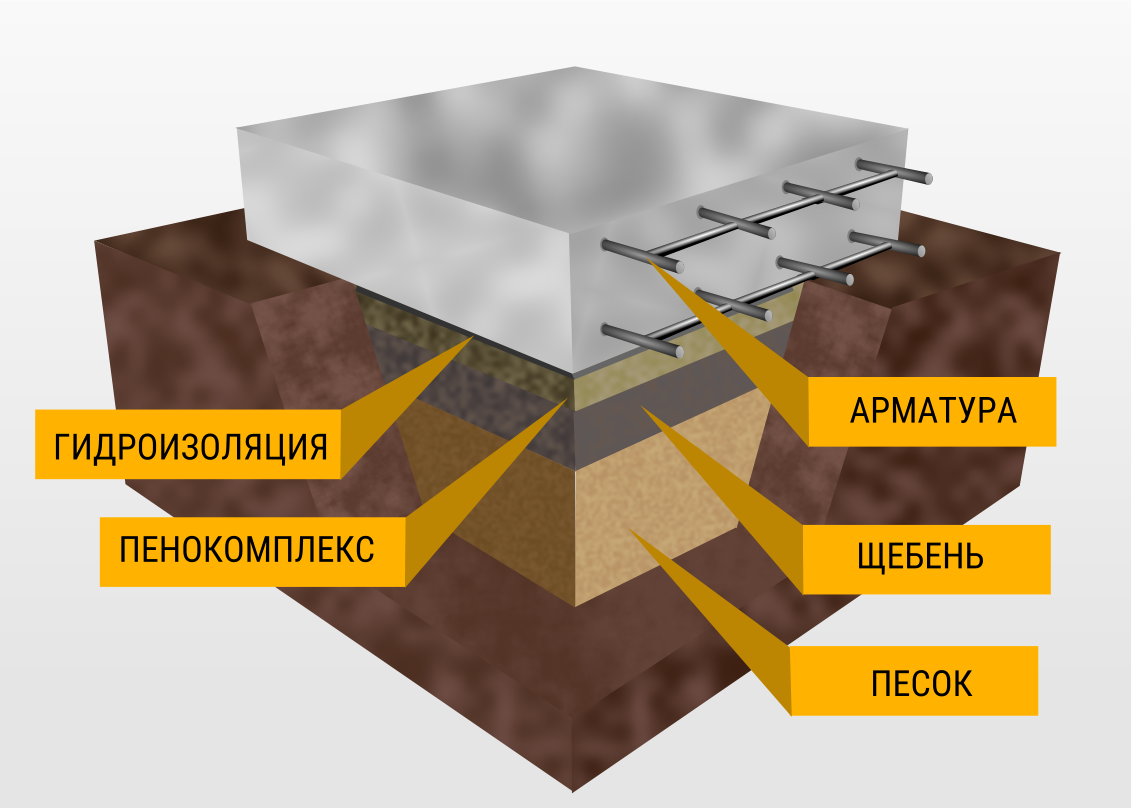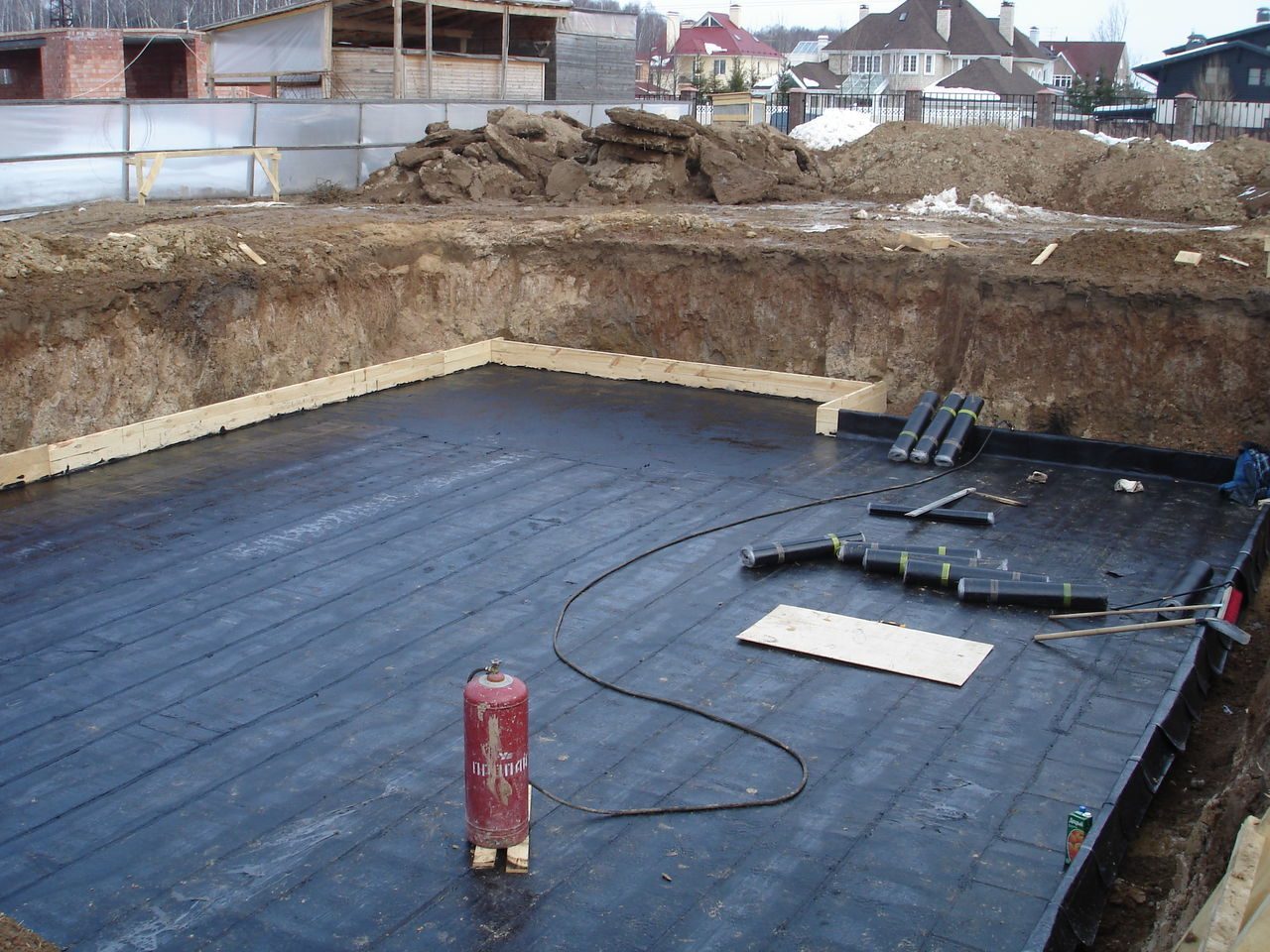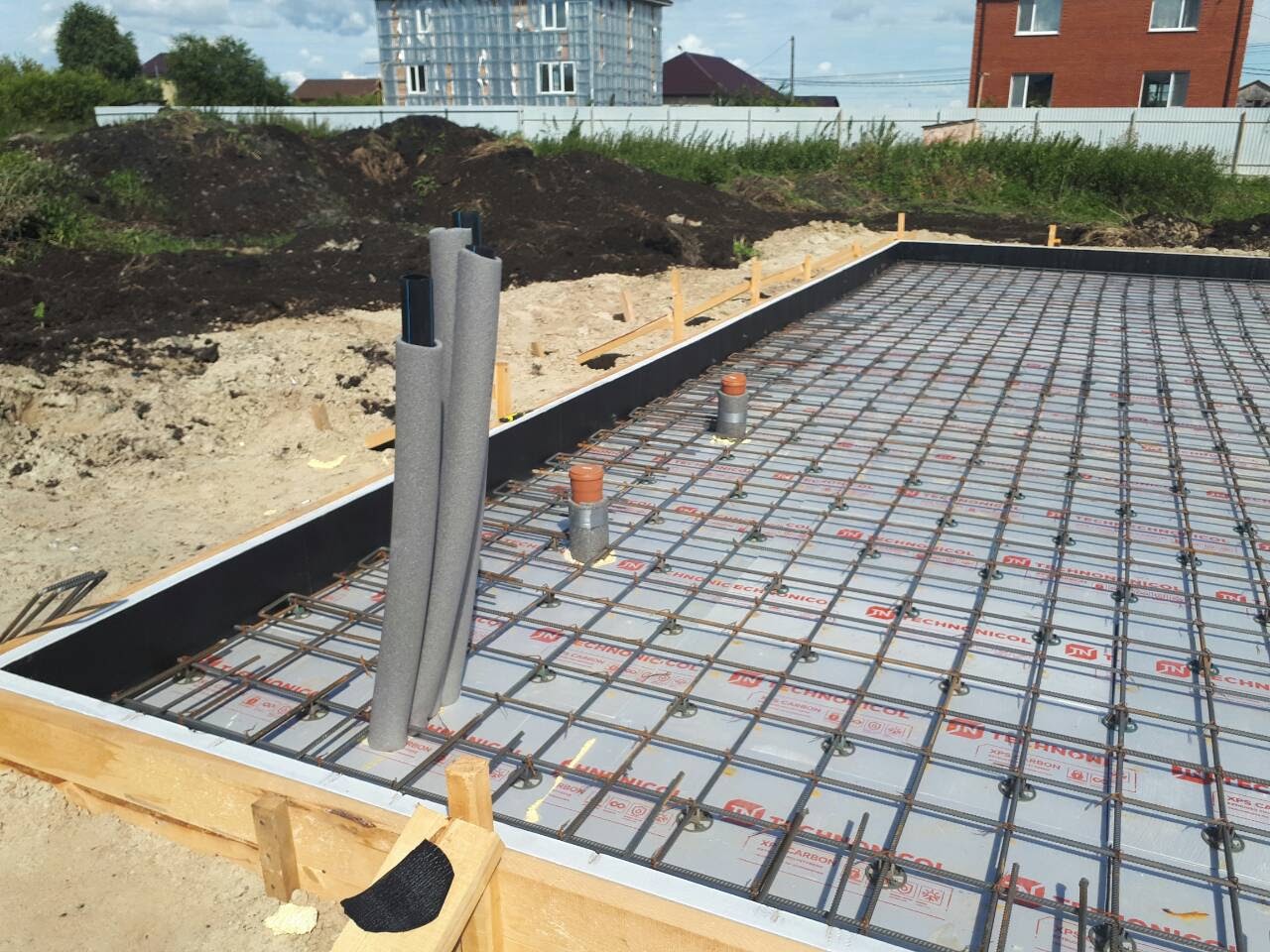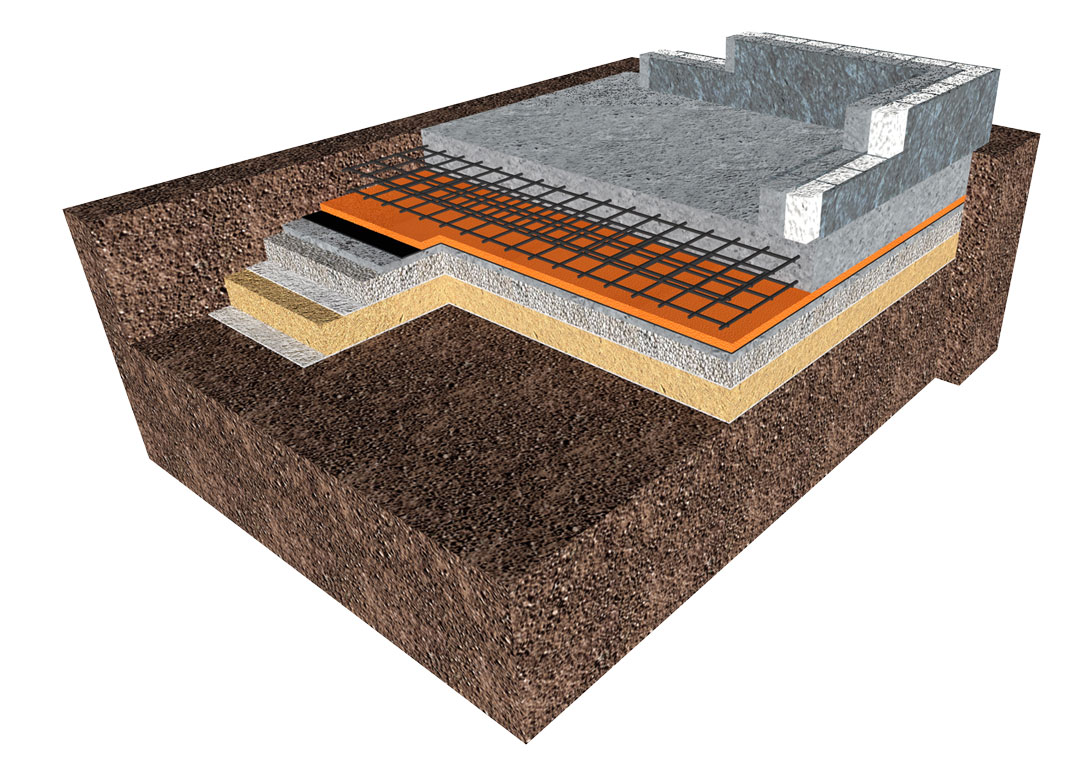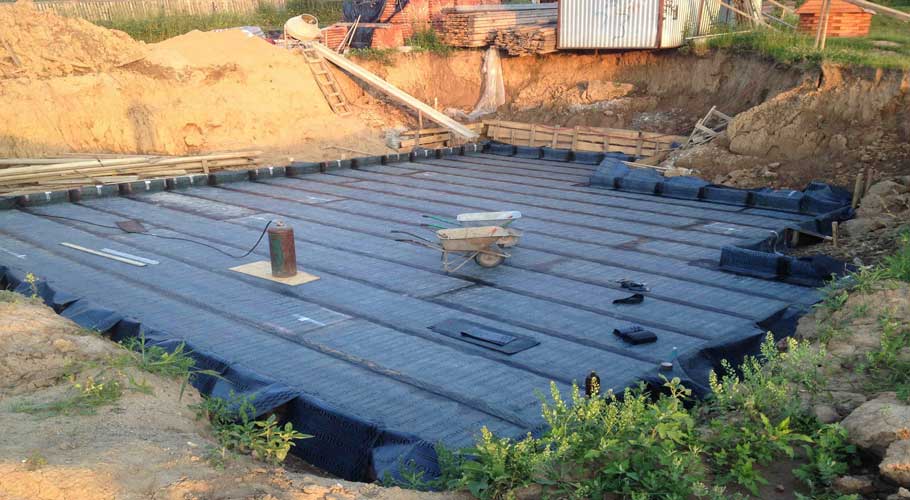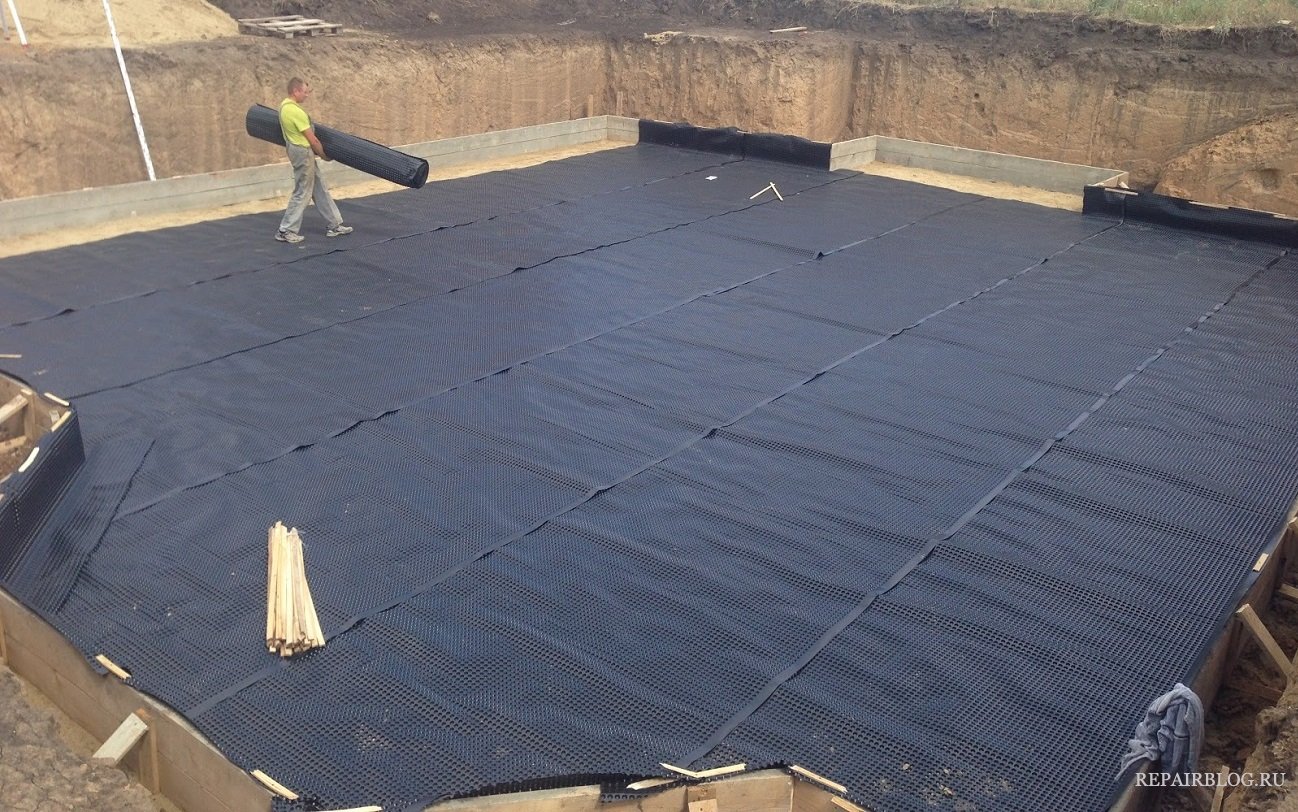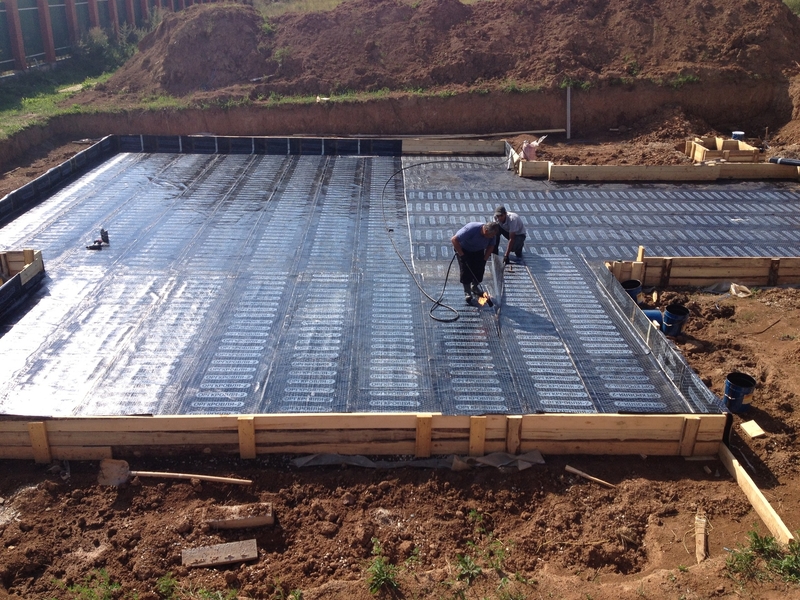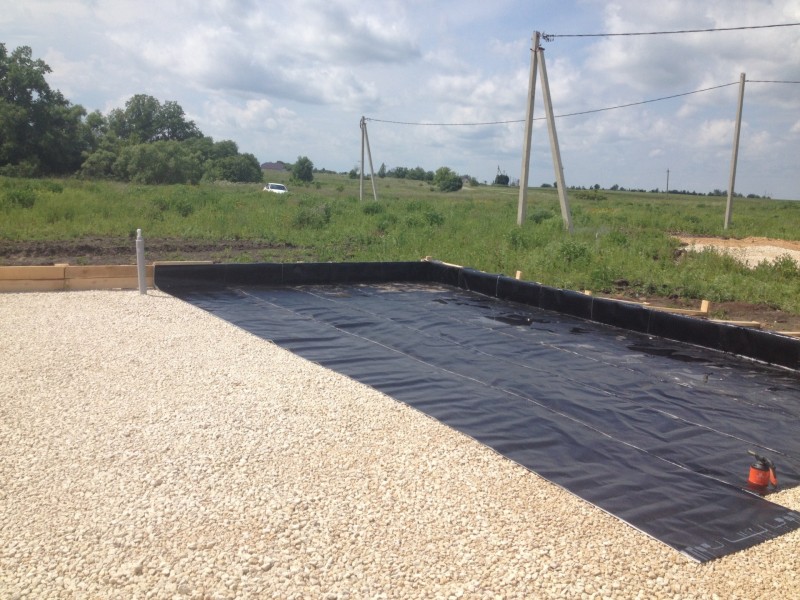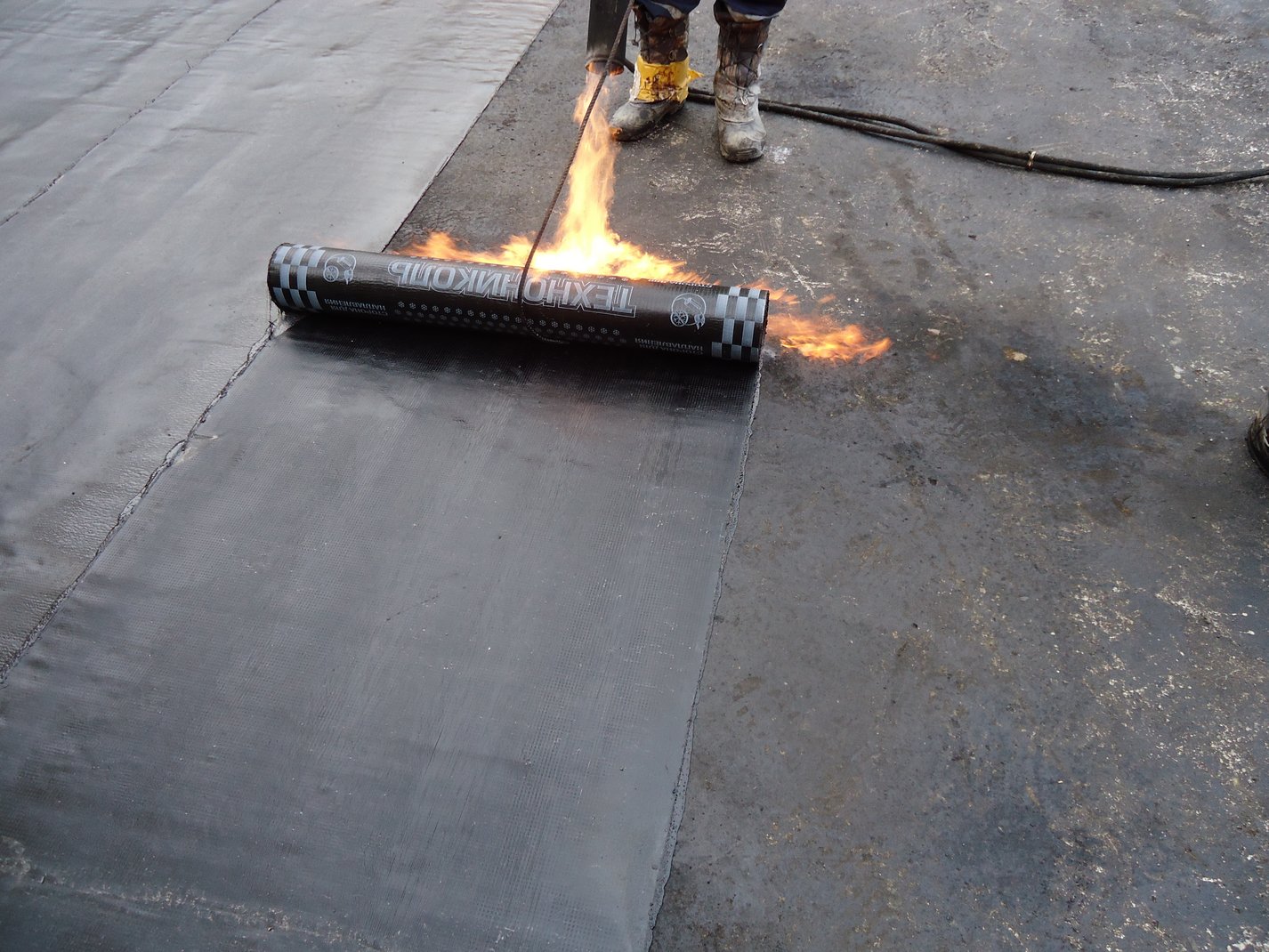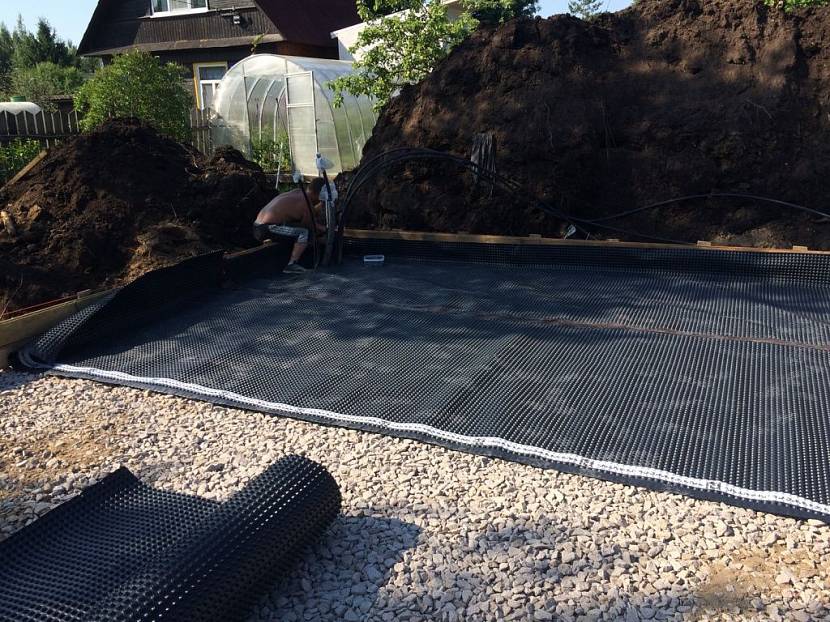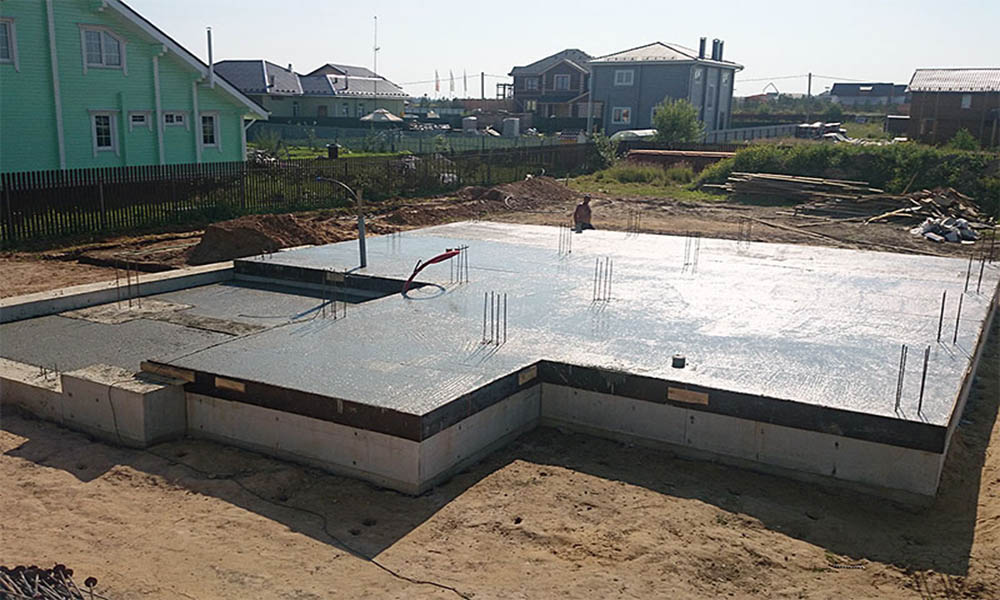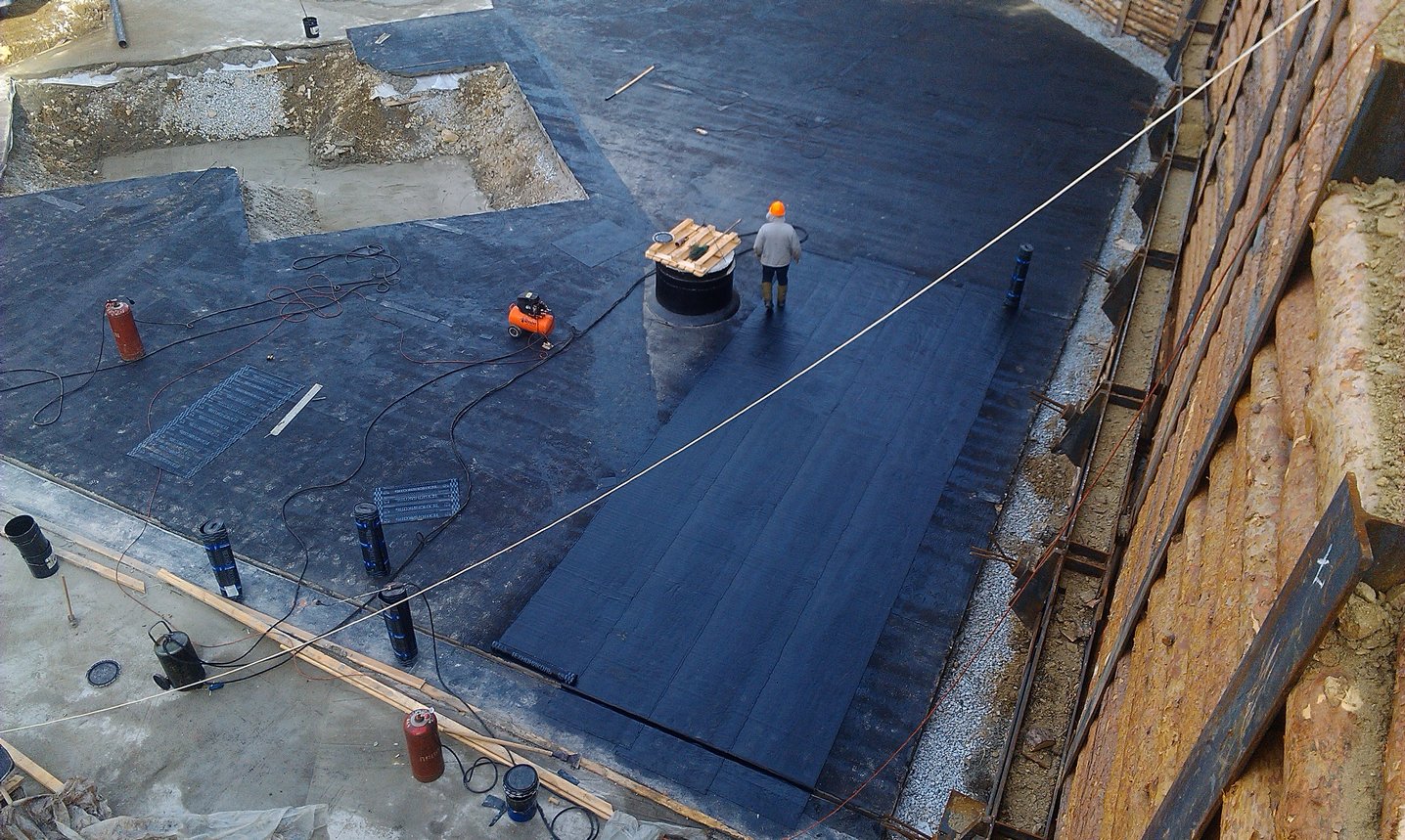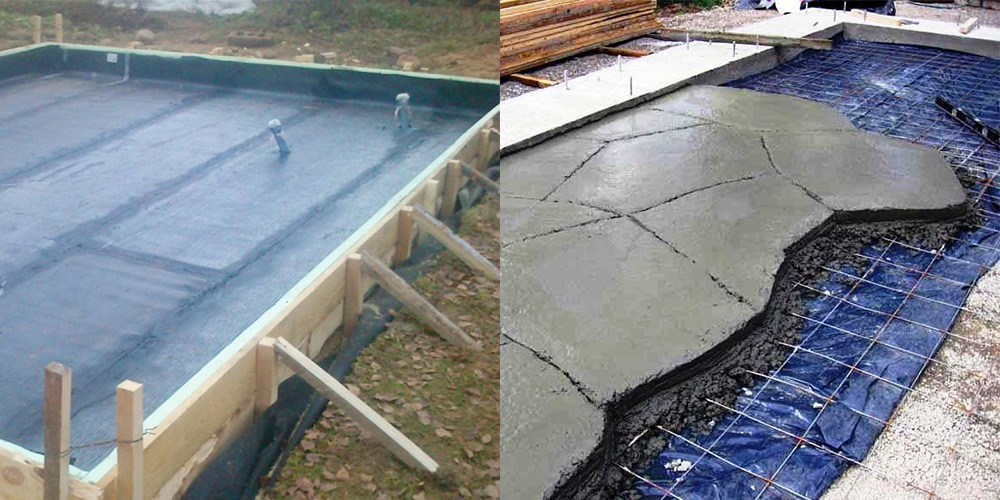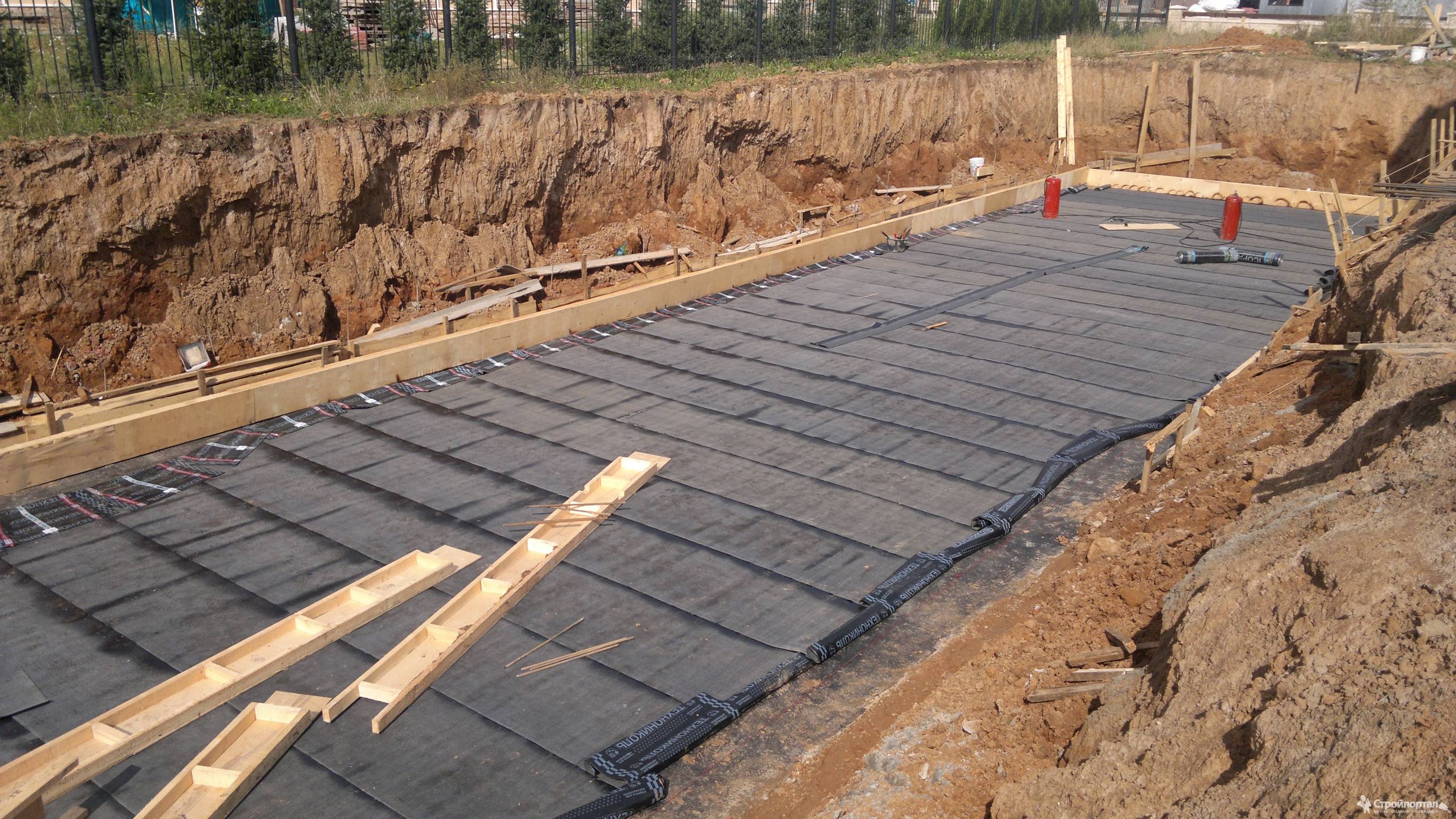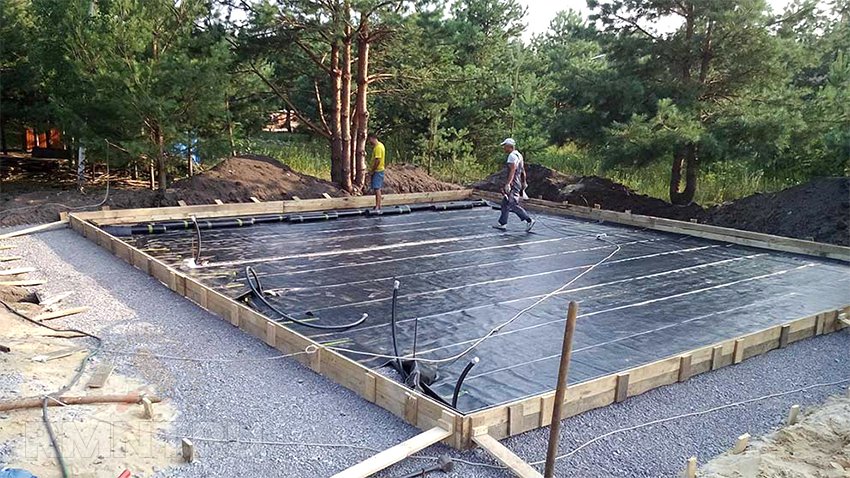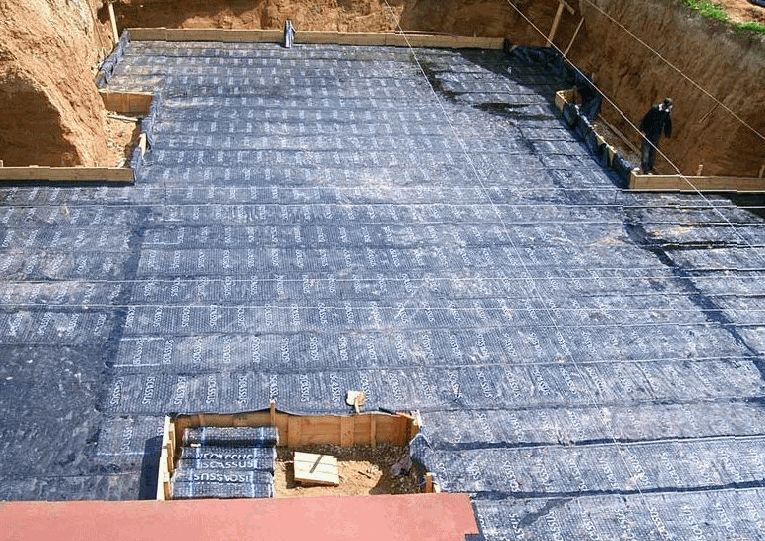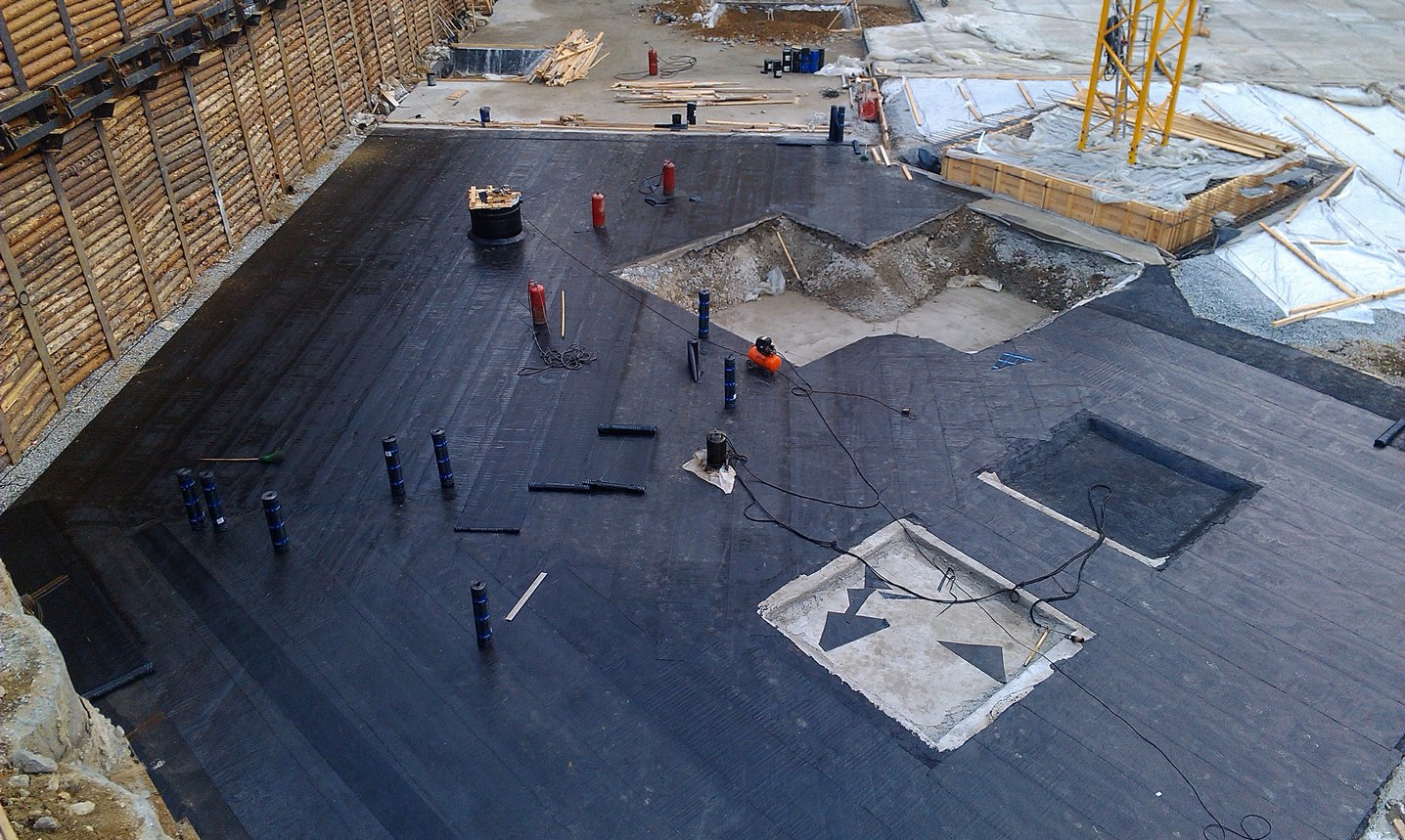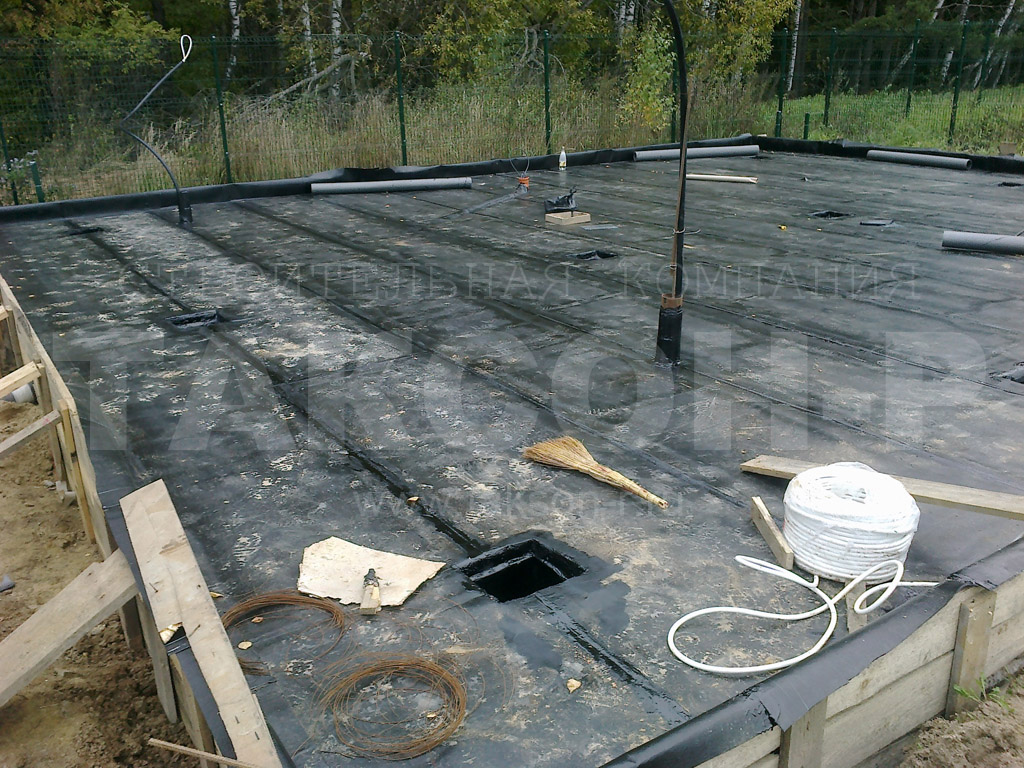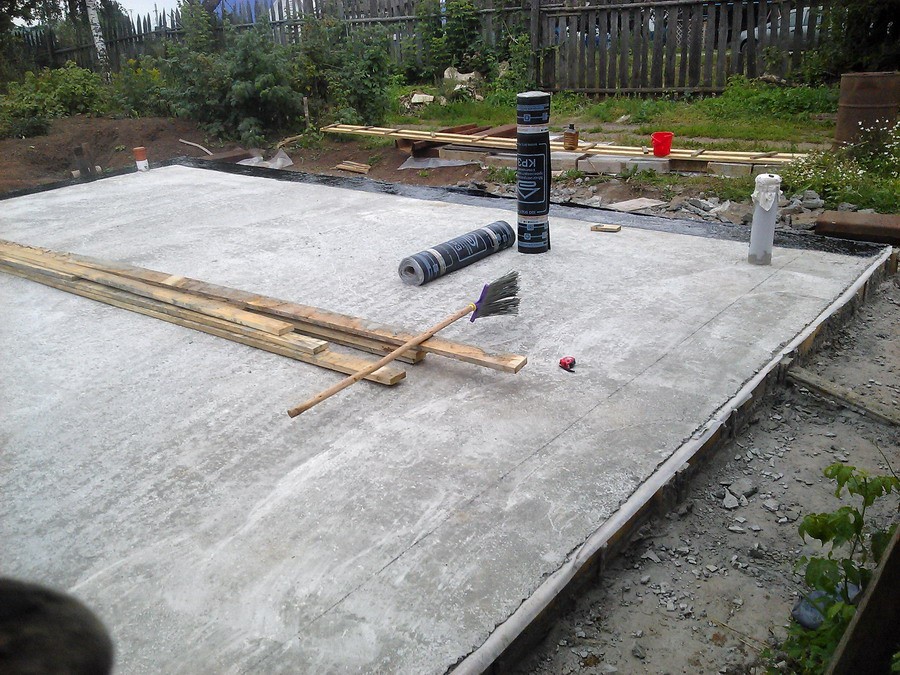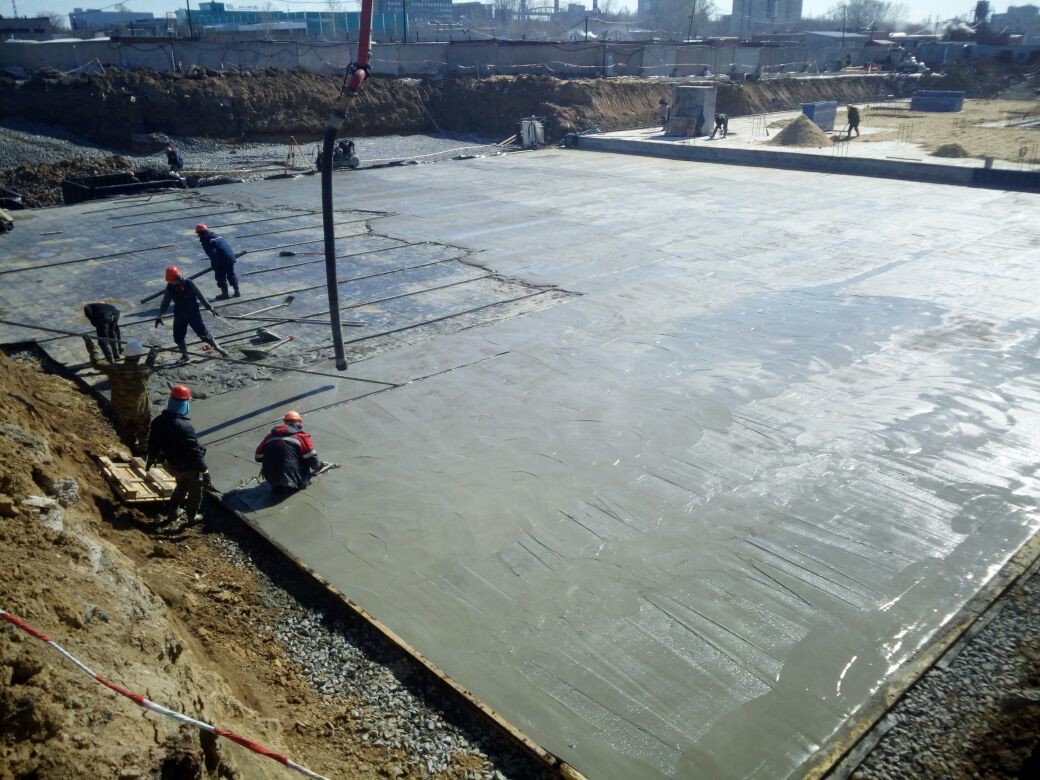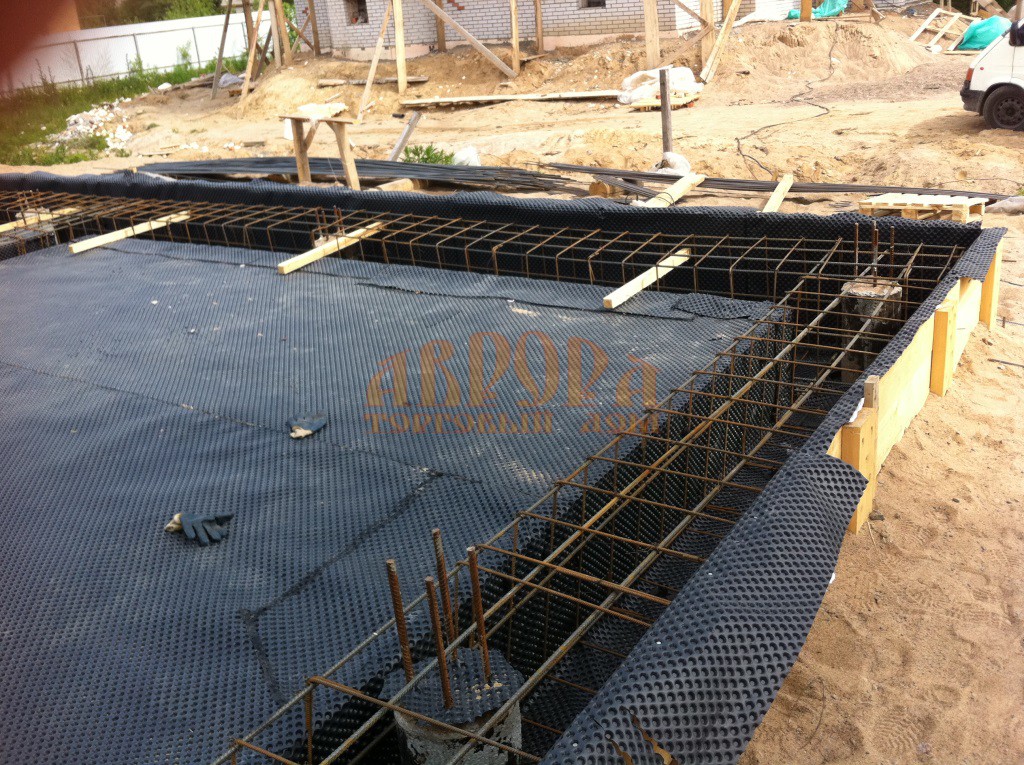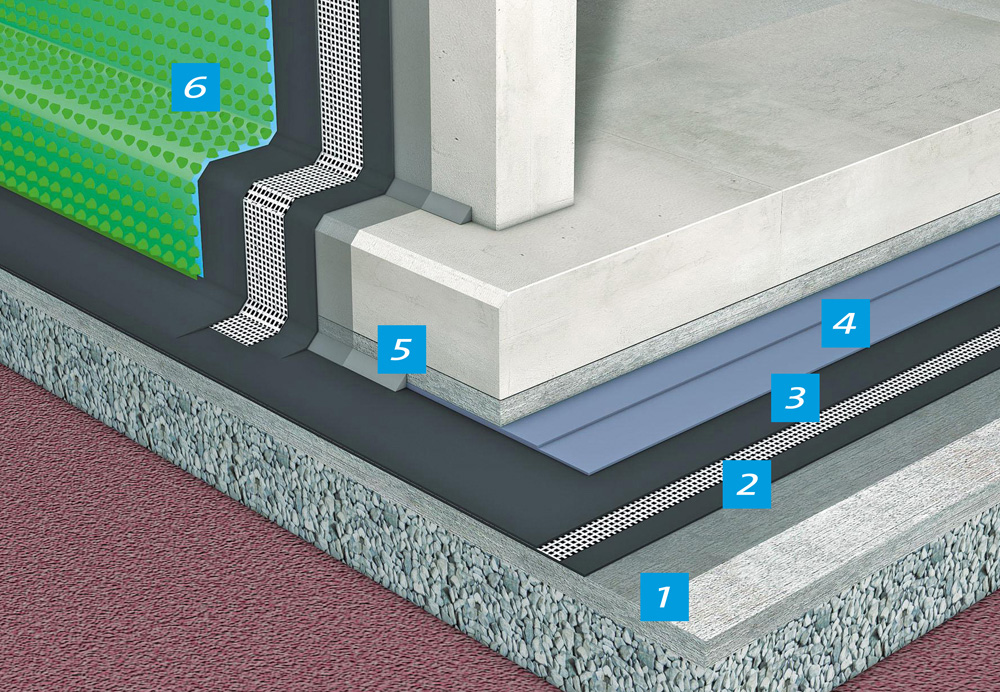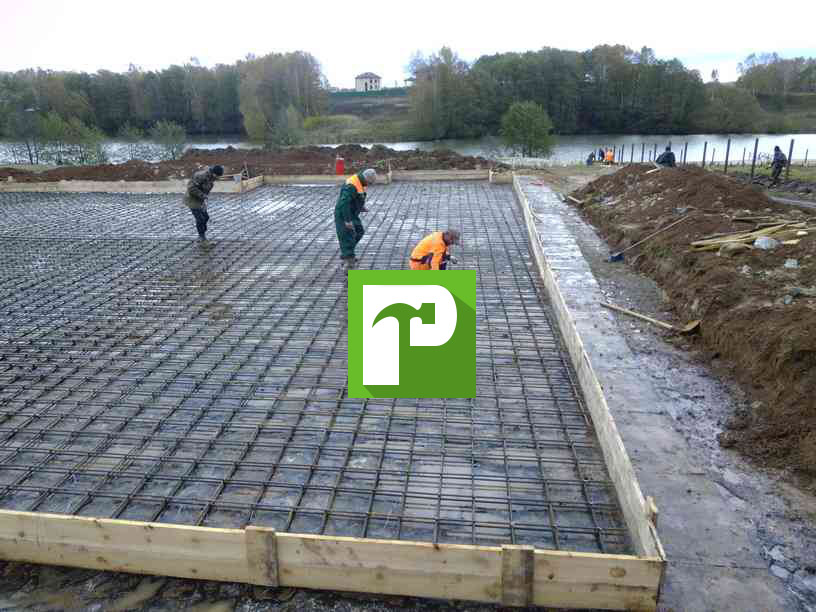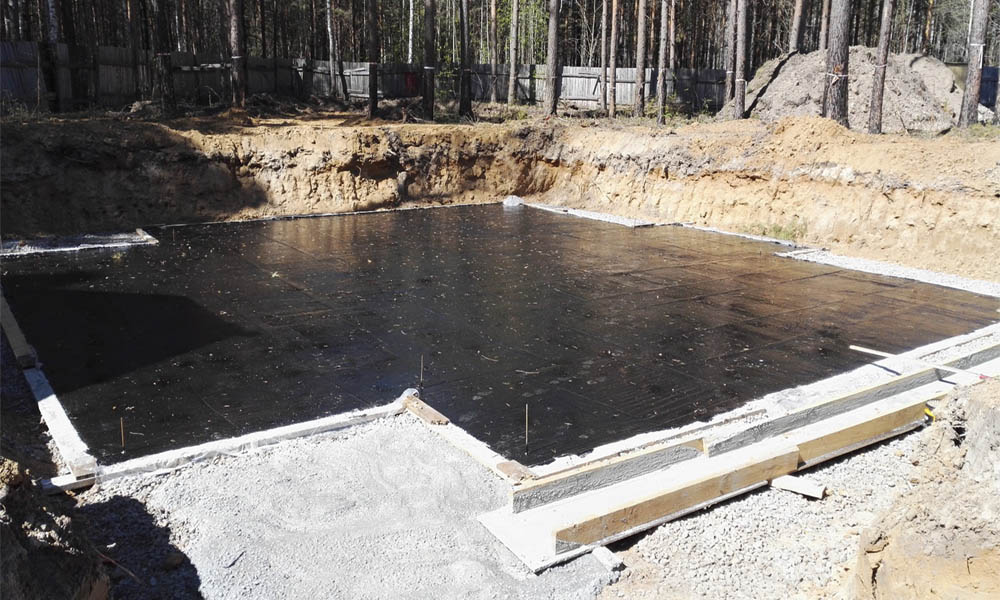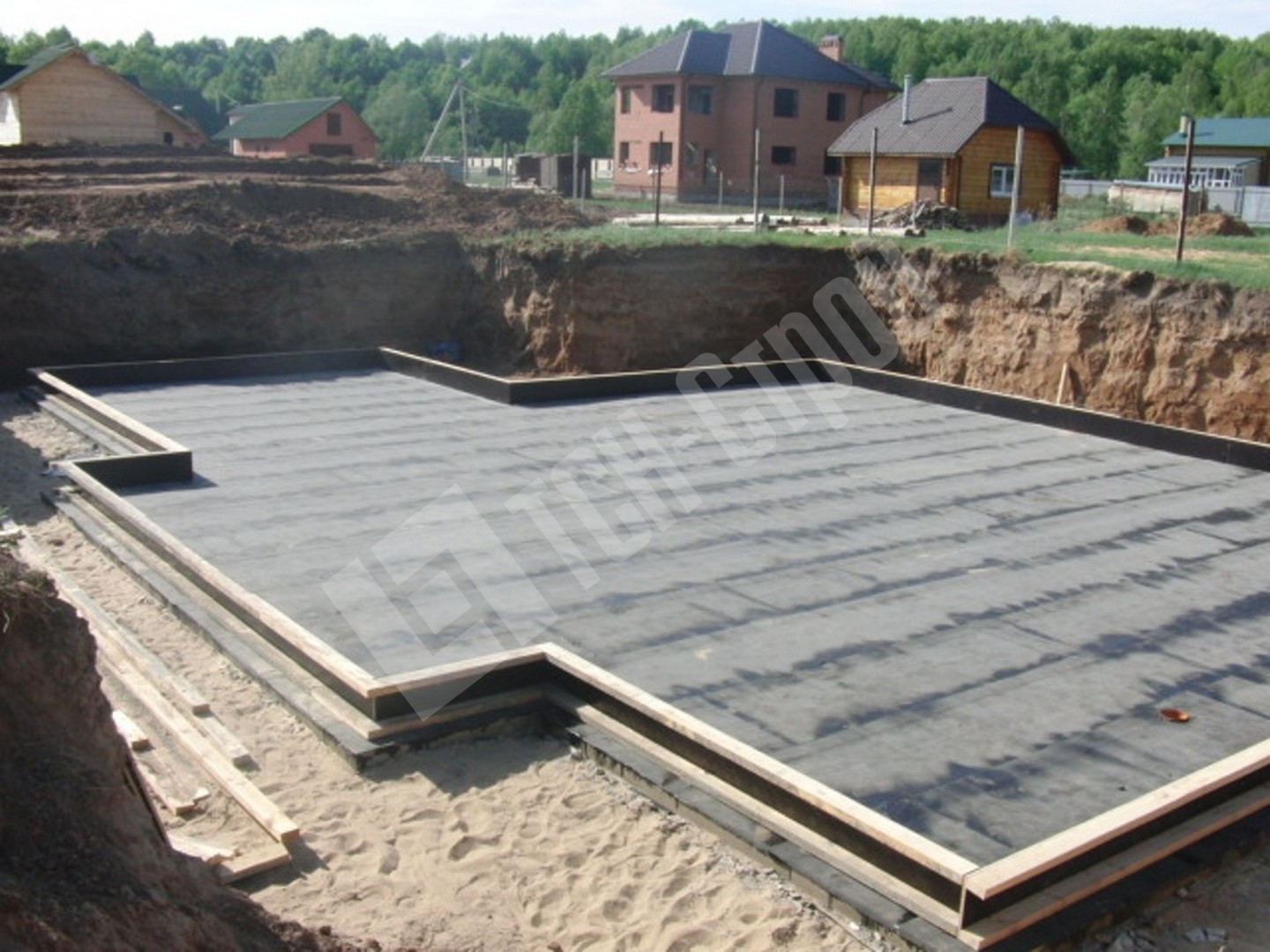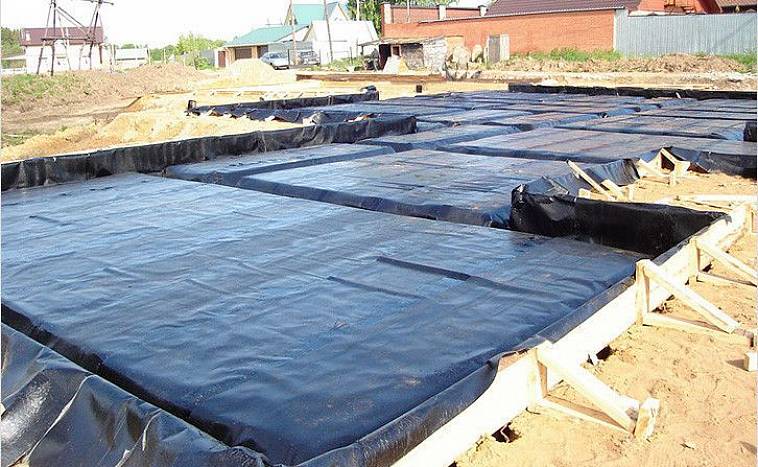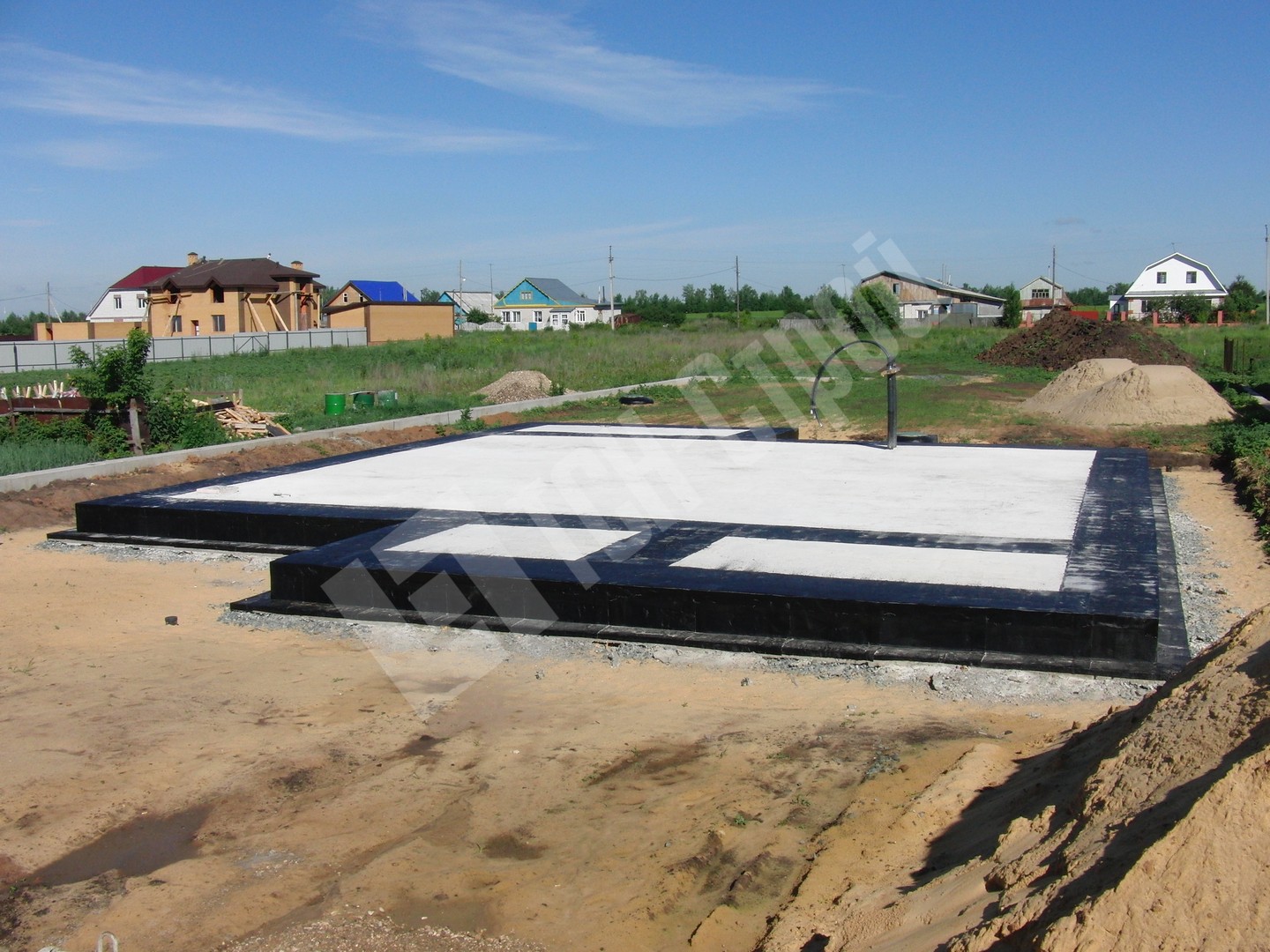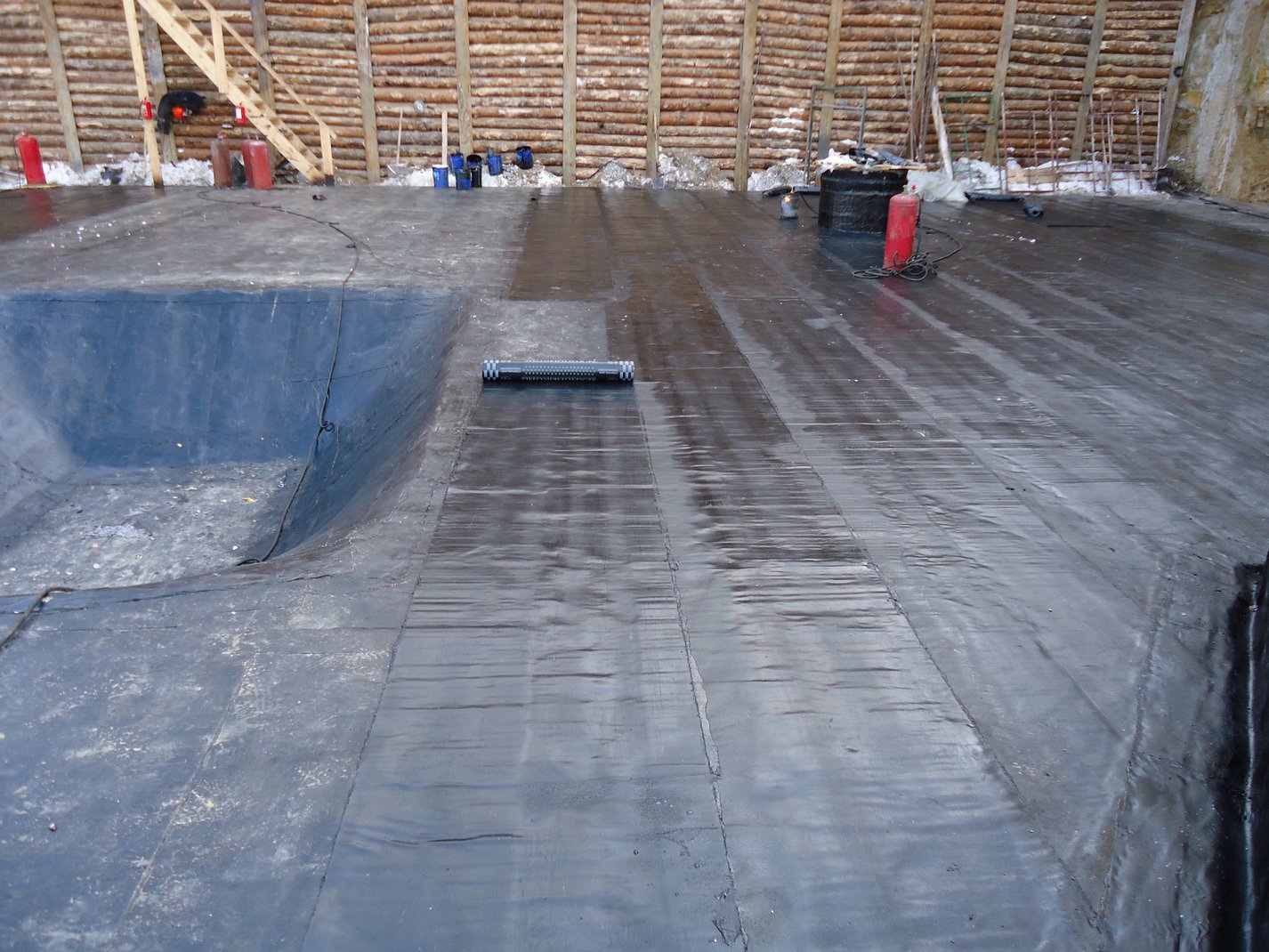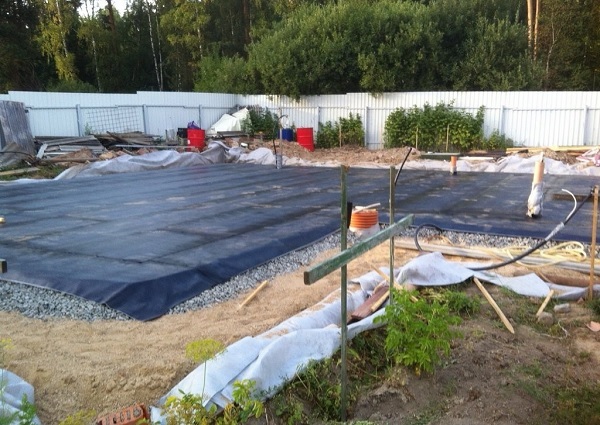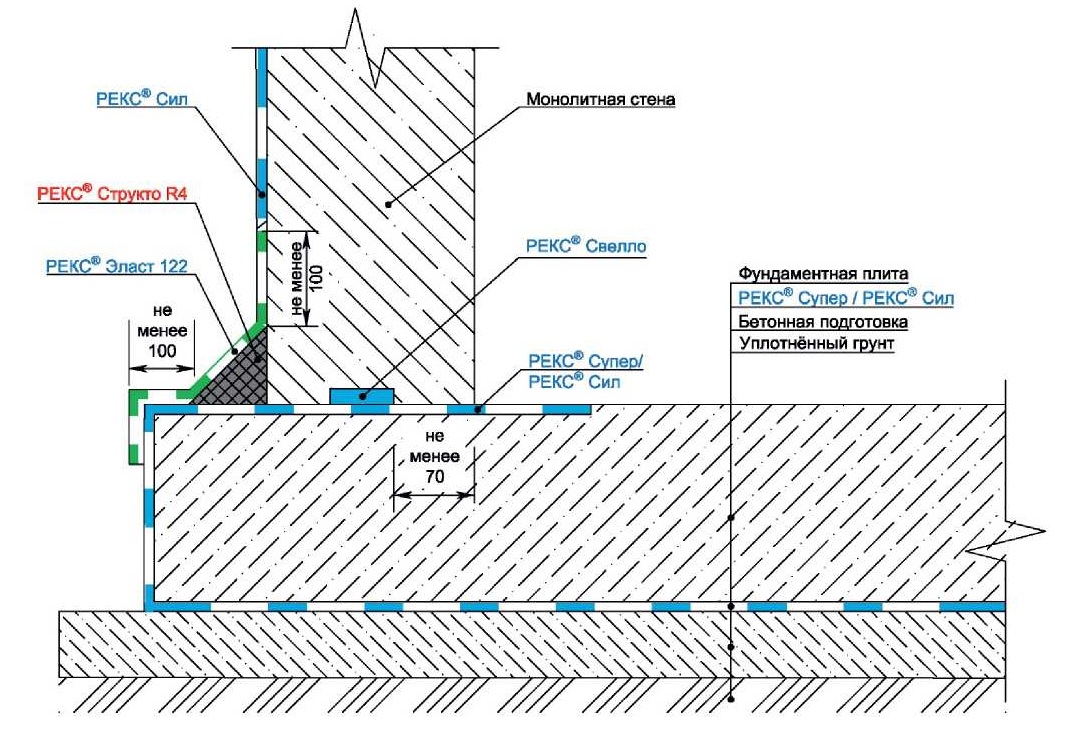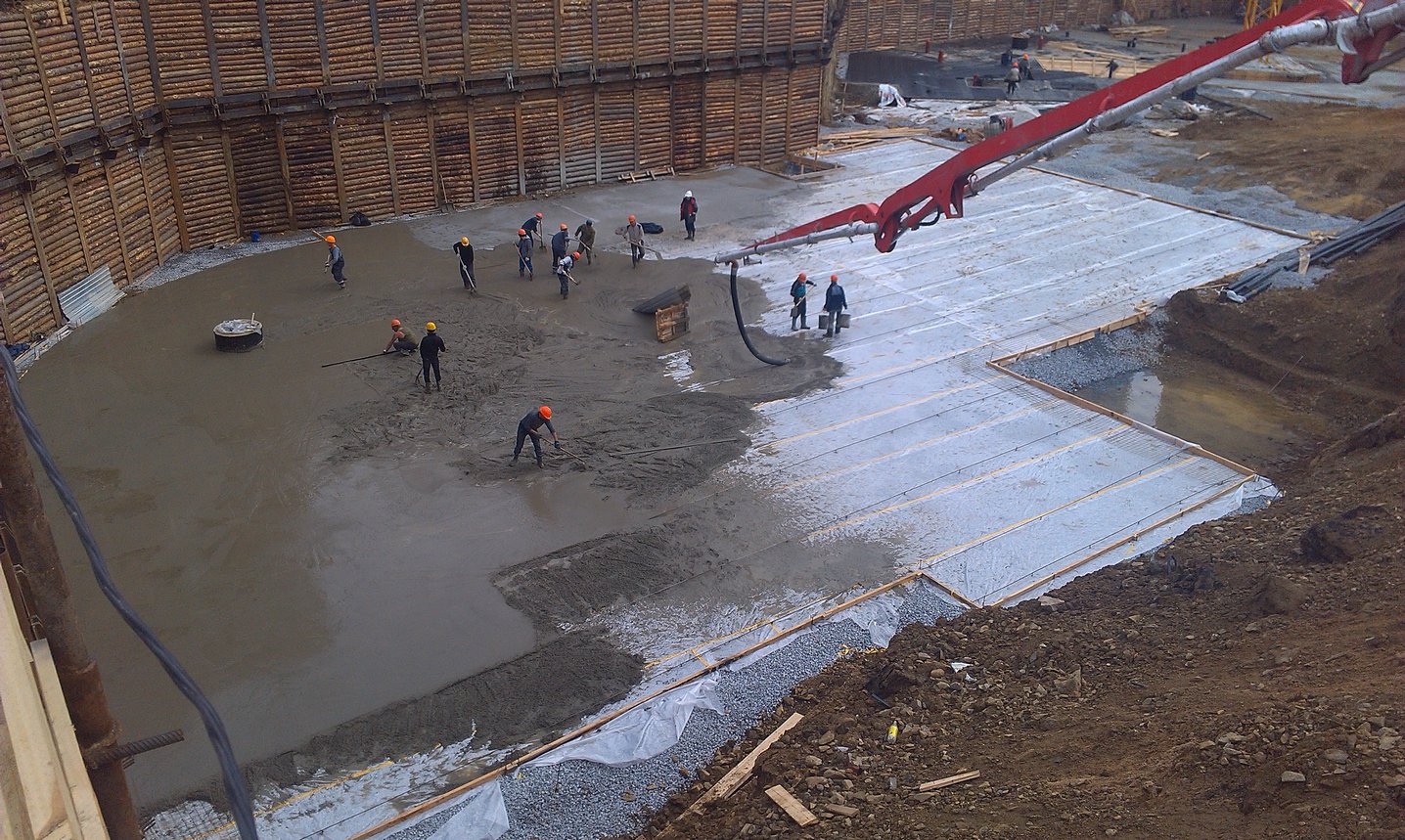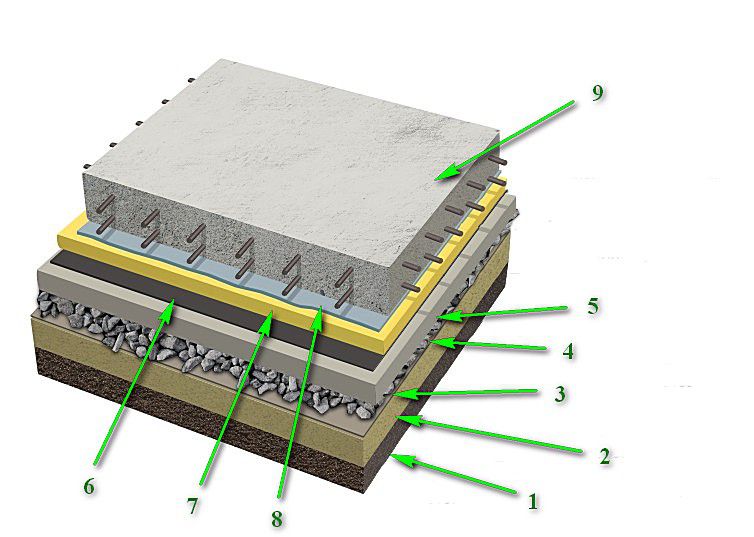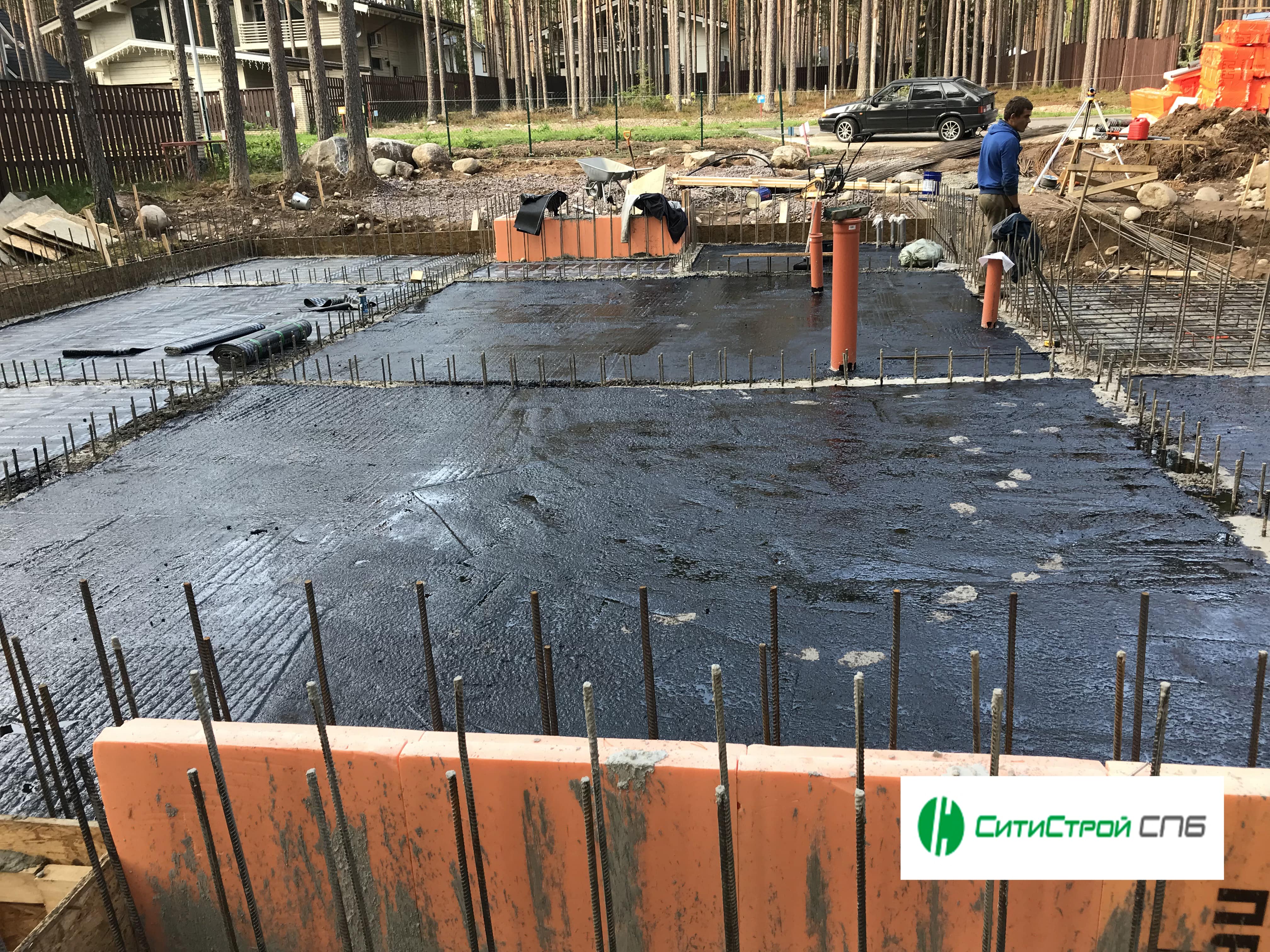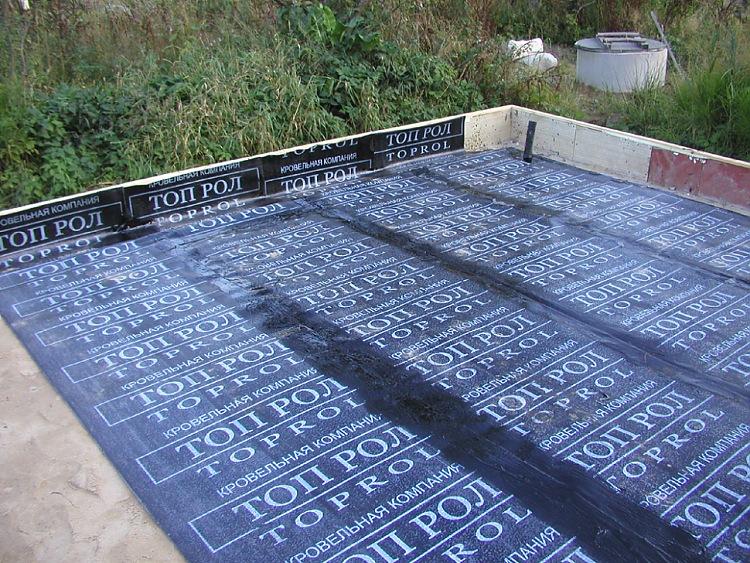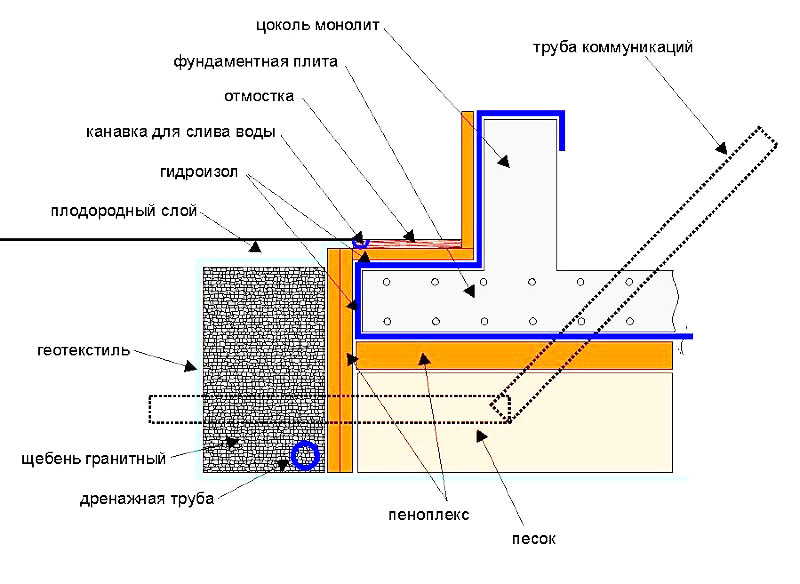Types of foundation slab waterproofing
What technologies are used to waterproof the foundation slab?
- Roll materials: membranes and films. The most common type, used in 90% of cases.
- Penetrating compounds. They fill the pores of reinforced concrete and prevent the capillary flow of moisture in the slab.
- Concrete admixtures leading to the effect of using penetrating waterproofing (for example, "Penetron Admix").
- Painting, coating and plastering waterproofing is used as additional: waterproofing of the foundation slab from below is not possible in this way.
Roll waterproofing

Waterproofing the foundation slab with roll materials has a number of advantages, among which it is considered to be an understandable and rather simple application technology with high waterproofing quality. You can do these works yourself without any special professional equipment.
As a result, a waterproofing layer of about 2 mm is obtained and is able to withstand a pressure of about 0.5 MPa.
Process order:
- Creation of a cushion (a layer of sand, a layer of crushed stone, 20 cm each) and concrete preparation.
- Roll waterproofing materials are laid on the frozen concrete preparation: in a 2-3 layer using bitumen or bitumen-polymer mastic (the joints of different layers should not coincide, the material is joined with an overlap of 15-20 cm).
- The release of the waterproofing layer beyond the aisles of the future slab is done by 30-50 cm.
After that, the formwork is installed, the reinforcement cage is made and the foundation slab is poured.
After removing the formwork, the waterproofing layer is wrapped around the sides and top of the slab.
It is not necessary to use any other materials for waterproofing the sidewalls (coating or plastering). This can prevent the waterproofing roll from being securely attached to the foundation at these locations.
Penetrating waterproofing

After the concrete has set 30% strength, penetrating waterproofing compounds can be applied. Concrete with 30% strength already allows movement on it, which is necessary.
Stages of applying the penetrating composition:
- Prepare the mixture. For Penetron, dilute the composition with water (0.4 liters per 1 kg of the mixture) to the consistency of sour cream. Convenient to use a mixer.
- Apply to wet concrete with a brush in two coats. The previous coat must dry before applying the next one. You can use a spray bottle.
The consumption of the mixture is approximately 1 kg / m2.
Concrete admixtures
If you are mixing concrete at the place of pouring, then special additives in concrete can be used to increase the hydrophobic properties.
Using the Penetron Admix supplement as an example, we will consider how to do this.
The additive is added to the water for the concrete solution (1.5 parts by weight of the additive to 1 water. The rest of the concrete mixing technology does not change.
It makes no sense to combine rolled waterproofing with penetrating waterproofing. There is no pressure pressure under the base of the slab and one of the waterproofing options can be dispensed with.
Basic principles of waterproofing
Before starting work on waterproofing the foundation slab, you must familiarize yourself with the basic requirements that apply to this process:
The insulating layer should be as dense and airtight as possible; the formation of cracks, tears and holes should not be allowed.
In places where groundwater and melt water can accumulate, additional protection must be provided.
A correctly made blind area is of great importance, it prevents the penetration of atmospheric precipitation to the surfaces of the foundation. After reading the current article, you can read how to waterproof the blind area.
With a close location of groundwater, a drainage system is needed around the building
This helps to lower the underground water level and prevents the destruction of the foundation.
In our previous article, we talked in detail about the drainage system for a slab foundation.
When choosing a waterproofing material, it is important to take into account the height of the foundation slab.
Waterproofing process of a monolithic foundation slab
Foundation waterproofing can be done in several ways. And, of course, each option has its own advantages and disadvantages. Currently, the most popular are:
The principle of action of penetrating waterproofing.
- Coating room. Very easy to apply, good results, long service life.
- Penetrating. A fairly new option. A distinctive feature of such a composition is that after its application, crystals are formed in concrete, which prevent the penetration of water into the structure.
- Waterproofing in rolls. The classic version that has been used for a fairly large amount of time. It is worth noting here that the service life of roll waterproofing is relatively short.
In the process of installing a slab foundation, a problem often arises regarding the waterproofing of the bottom slab. This is due to its large enough area. In most cases, this problem is solved by means of roll or coating waterproofing.
As already noted, not so long ago, roofing material was used for waterproofing. This is a material in a roll in which bitumen is applied to a cardboard base. It is worth saying that roofing material cannot boast of its durability, because bitumen quickly loses its elasticity, and cardboard does not possess high strength.
The composition of the roll waterproofing.
At the present stage, materials are used in a roll, but they already include fiberglass or fiberglass. Moreover, modifying additives are included in the bitumen composition, which make the material the most elastic.
Waterproofing in a roll is quite convenient to lay under the foundation slab. It does not require a special tie. Seams that appear between the strips of material must be glued together with bituminous mastic. Installation is relatively quick. For laying, only a burner is needed so that the mastic can be heated.
It is necessary to apply such mastic with a roller or brush. The whole problem is that in order to waterproof the lowest part of the foundation, you need to put a cement screed on a cushion of sand and crushed stone, on which bituminous mastic is subsequently applied. After the slab is poured, a waterproofing layer must be applied to its sides and top.
In the same way, you can create a layer of waterproofing by means of penetrating compounds. The result of this application is the sealing of the pores of the concrete. Crystals form inside the concrete base, which do not allow moisture to penetrate inside. Currently, this type of waterproofing is considered optimal and modern.
What is the waterproofing of the slab foundation for?
The monolithic mass contains small pores, which, at high humidity, act as capillaries.
Unprotected concrete gradually absorbs moisture, which causes negative consequences:
- the strength characteristics of the monolith are reduced with constant waterlogging;
- water is concentrated in the pores, which increases in volume during crystallization;
- a damp base will cause dampness in the room, leading to mold.
In the absence of waterproofing, the foundation will gradually deteriorate. This will accordingly affect the sustainability of the building.
Whatever method of foundation installation you choose, it is important to remember that measures to cut off soil moisture from it are mandatory
Hydroprotection solves a number of serious problems:
- seals the concrete while maintaining its integrity.The concrete mass is weakened when moisture freezes;
- allows you to maintain a favorable indoor climate. Under normal humidity conditions, mold does not form;
- increases the service life of the base. The rise of moisture through the capillaries stops, which has a positive effect on durability;
- protects reinforcing bars from corrosion. Waterproofing the foundation retains the strength properties of the reinforcement.
Cutting off moisture inside the house ↑
Waterproofing only begins with the foundation: moisture must be cut off in the building itself. This is especially true for multi-storey panel buildings, for which bays and floods are commonplace. There is also capillary filtration of moisture, primarily in rooms subject to constant moisture - bathrooms, toilets, kitchens.
Floor slab waterproofing is carried out in different ways, the main of which is roll, coating and penetrating waterproofing.
Roll materials are mainly used in kitchens and bathrooms. Before laying the decorative coating (most often ceramic tiles act in its role), a cement screed is applied to the laid waterproofing. It protects the material from damage and serves as the basis for high-quality tiling. In "wet zones" the waterproofing roll is laid on the floor with an overlap of at least 20 cm on the lower part of the wall. This avoids the penetration of moisture in case of large leaks.
Lubricating waterproofing is easier to use, because applied to the prepared substrate with a spray gun or brush. Its advantage is a longer service life, as well as the fact that in this case there is no need for an additional screed, therefore, the floor level rises slightly.
Penetrating waterproofing is the most reliable way to protect floor slabs from moisture penetration
These materials have another important advantage: manufacturers produce special joint compounds that are placed directly into the joints between the slabs. This method of waterproofing is the most reliable.
Another plus is that it can be applied on mineral substrates, which include plastered surfaces, therefore, it can be used after finishing the rough finishing of walls and floors.
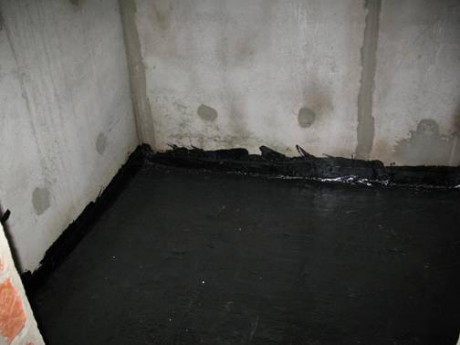 Waterproofing is laid at the stage of rough finishing
Waterproofing is laid at the stage of rough finishing
Roll waterproofing under the foundation slab
Waterproof materials are produced on a different basis:
- bituminous;
- polymeric.
They are supplied in rolls and fixed in various ways:
- by fusing onto concrete using burner heating;
- by gluing using special mastic.
The traditionally used material is roofing felt. It is a cardboard base impregnated with bitumen.
Roll. A well-known method that fully justifies itself, although the durability of such waterproofing is not too great
The main advantages of the application are:
- cheapness of the material;
- ease of fixation.
The list of disadvantages significantly exceeds the list of advantages. Weaknesses of the material:
- fragility at negative temperatures;
- insufficient strength;
- limited service life;
- tendency to cracking at bends;
- low elasticity of the hydrophobic layer.
The outdated roofing material is being replaced by modern waterproofers:
- glass roofing material;
- glass-insol;
- hydroisol;
- rubemast.
Laying is done quickly and easily, from the devices, only a burner is enough to warm up the mastic
The waterproofing of the slab with roll-up waterproofing is carried out by laying a protective layer on a compacted gravel-sand bed. In this case, an overlap of the canvases of 15–20 cm should be ensured. Concrete can be poured onto the waterproofing material. After hardening, it is necessary to waterproof the top and end surfaces.
For this you need:
- Remove dust from them.
- Cover with mastic.
- Cut the canvases.
- Glue the roll-up moisture protection.
To perform work, you can use any type of roll-on waterproofers.
Monolithic slab waterproofing - foundation protection methods
Builders prefer the following waterproofing methods:
coating. Differs in increased efficiency, simplicity and provides effective protection against moisture. It is carried out by applying special emulsions or mastics to the surface. According to the manufacturer's recommendations, the selected composition is applied to the surface to be treated in a hot or cold state;
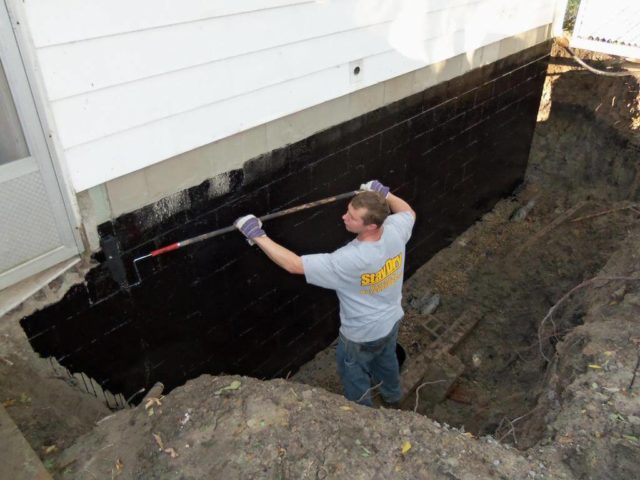
It is known that water is extremely corrosive towards most building materials, and, in particular, to concrete, from which foundations are made.
- penetrating. This is a modern and promising method of waterproofing, providing an increased depth of penetration of the protective composition deep into the concrete mass. After application, the special mixture crystallizes in concrete pores and, as a result of the hydrophobic effect, makes it difficult for external moisture to access;
- roll. This is a fairly common method involving the use of moisture resistant materials supplied in rolls. The position of professionals regarding roll moisture protection is ambiguous. Some consider this method outdated, others emphasize its effectiveness and simplicity.
The decision to use the moisture protection technology is made individually, taking into account the following factors:
- location of aquifers;
- the amount of precipitation;
- the presence of drainage lines;
- design features of the base;
- financial opportunities.
Is it true waterproofing of a monolithic foundation slab
Related materials:
- Recommendations of the Central Research Institute of Industrial Buildings for waterproofing underground structures;
- Manual of TsNIIOMTP MDS 12-34 on waterproofing works;
- SP 45.13330 for foundations, foundations and earthworks;
- SP 41.13330 for hydraulic structures, reinforced concrete and concrete structures;
- SNiP 3.04.01 for finishing, insulating coatings.
There is no type of waterproofing that cannot be applied to a slab foundation. When choosing a waterproofing technique and materials, you should start from the budget and look for the best waterproofing option in the budget niche in terms of price and quality ratio.
The foundation, like any underground structure, is exposed to soil moisture from various sources:
- The groundwater. The groundwater level strongly depends on the relief and depth of the water-resistant layer. Groundwater levels fluctuate seasonally.
- Filtration water. Melted and rainwater, as well as various drains.
- Soil moisture.
Problems solved by waterproofing the foundation slab:
- Corrosion protection of the reinforcement cage;
- Protection of above-foundation structures from moisture penetration into them through the foundation;
- Protection of concrete from destruction when wet and negative temperatures.
To select the type of waterproofing, you need to decide on the hydrostatic pressure on the base of the foundation slab and the level of humidity. For the right choice, you need to take into account the price of materials, as well as the prevalence in your region.
Subject to certain factors, it is allowed not to waterproof, but this will reduce the life of the foundation:
- The slab lies on the ground without deepening;
- A dump of 20 cm of sand and 20 cm of crushed stone is made under the slab;
- The groundwater level is always below 1 m below the surface;
- An annular drainage is made along the perimeter of the foundation;
- The filling of the side faces is made with sand;
- Blind area made.
In this case, flood and rainwater runoffs go along the blind area and enter the drainage system. The water that has been absorbed into the soil does not affect the foundation thanks to the sand-crushed stone cushion.
But it is better to insure yourself and make waterproofing.
Preliminary points that have little to do with waterproofing, but which need to be considered:
Before pouring the slab, the fertile layer must be removed;
For reliable plumage, a pillow is made of sand and crushed stone (the bottom layer is sand, the top is crushed stone, or a mixture);
Crushed stone for the pillow is used in the middle fraction, coarse crushed stone can damage roll waterproofing materials;
The pillow is leveled and rammed, this is important for high-quality joints of roll waterproofing.
Concrete preparation can facilitate the task of creating an even and smooth cushion under the foundation. And on top of it a layer of roll waterproofing is laid, and then the slab is poured.
The waterproofing layer is made with an allowance, so that then these edges can be wrapped from the sides of the slab and fixed on top as in the figure. Thus, a single waterproofing layer is created.
How to secure the joints of precast foundation slabs: features
It should be understood that individual elements of the foundation need to be protected from moisture in the same way as the structure as a whole. The joints formed during installation are filled with a material such as concrete, which tends to absorb moisture to a large extent. To prevent this, it is necessary to use polyurethane cords, sealants and coating waterproofing for sealing the joints.
Thus, waterproofing a foundation is a very important and mandatory process. Having penetrated into the foundation, water will contribute to its further destruction. The result of what is happening will be a rework of the foundation and major repairs. In order for the building not to suffer, at first it is necessary to think about its waterproofing. This process involves a lot of complexities.
Therefore, if you do not have certain skills in such a matter, then it is best to entrust its resolution to professionals.
What is foundation slab and moisture protection
Diagram of a foundation slab with waterproofing
This type of foundation is popular with many builders as the slab is able to withstand heavy loads. Such a foundation is installed at a shallow depth, it can be shallowly buried or not buried. The depth of occurrence rarely exceeds 40-50 cm, but the area of the slab foundation is quite large. A reinforced concrete slab is installed, as a rule, on a ready-made pre-made sand and gravel cushion.
Depending on the permissible loads from the future building and the characteristics of the soil, slabs are monolithic and prefabricated. Monolithic slabs are a single reinforced slab of specific dimensions and thickness; in such cases, the pit is equipped with formwork and a reinforcing cage, then poured with concrete of the required grade. Prefabricated structures are reinforced concrete slabs connected into a single whole with the help of a concrete solution, which are actively used in the construction of roads for various purposes.
Regardless of the type of base and its structure, any concrete is susceptible to moisture and deteriorates over time. Therefore, waterproofing of the foundation slab is done in any case and it is recommended to initially select the optimal technology.
Water is a universal solvent for mineral salts, and concrete is almost 100% mineral compounds. Concrete also has a porous structure due to the use of crushed stone, so water gets inside the pores and dissolves salts.
There is also the problem of dampness in the walls. The material of the walls draws moisture from the soil, so dampness occurs inside the premises, a fungus appears slowly destroying the structure of the house.
This is interesting: Options for waterproofing the foundation from FBS blocks - we consider in order
Waterproofing foundation slabs
Water is an aggressive medium that negatively affects the condition of the foundation slabs, which is why waterproofing measures must be carried out without fail.In this article, we will look at what waterproofing of a foundation slab is, how it should be carried out and what advantages it gives.
The article should begin with a description of the slab foundation, its structure and installation method. This type of foundation refers to non-buried or shallow structures, depending on the type of soil. To lay it, you must first create a pit. The reinforced concrete slab is installed on a pre-organized cushion made of sand and gravel, which, in turn, have been compacted tightly.
The slab foundation can be of two types: monolithic and prefabricated, each of which requires laying waterproofing. In the first option, the already prepared formwork is poured with ready-mixed concrete. A frame made of reinforcement is pre-installed. The second option for laying a slab foundation involves the compilation of a structure from pre-prepared reinforced concrete blocks, which may differ in their structure.
Regardless of the type of foundation chosen, it is necessary to arrange a reliable waterproofing of the slab in order to ensure its durability.
Water can have an extremely negative effect on the condition of many building materials, including concrete, which serves as the basis for the foundation slab. The negative consequences are associated with its porous structure, which perfectly absorbs moisture that gets into it.
Due to the fact that in the water penetrating from the soil into the concrete there are impurities of mineral salts, the slab is destroyed without proper waterproofing. The reason for this is the processes of crystallization and an increase in the volume of water, the structure is subjected to pressure from the inside, its strength decreases, which can lead to the collapse of the building.
A possible negative effect of water can also be due to the fact that when it gets into concrete, it washes out all salts and a number of other elements from it. This leads to an early destruction of the structure. In the absence of high-quality waterproofing of the foundation slab, the walls can begin to draw moisture from the foundation, which causes mold and dampness in the house.
Foundation waterproofing can be done in several ways. Each option has certain advantages and disadvantages. At the moment, there are 3 most common methods of waterproofing a slab foundation.
• Lubricated insulation. Simple process of applying the material, fast and high-quality result, long service life. The material is applied by hand or machine.
• Penetrating insulation. The active chemical components of waterproofing dissolve in water and react with ionic complexes of aluminum and calcium, metal salts and oxides contained in concrete. In the course of these reactions, more complex salts are formed that can interact with water and create insoluble crystalline hydrates.
• Waterproofing in rolls. Diffuse film membranes or gluing materials (roofing felt, glassine, etc.) are used, which are laid on top of a "pillow" of sand and gravel.
During the installation of the slab foundation, there may be a problem with ensuring the insulation of the bottom slab, since it has a sufficiently large area. The solution is to use roll or coating waterproofing of the slab.
Foundation waterproofing cost
For many, the situation is familiar when the team is trying to save on materials. This also applies to waterproofing the foundation. As you know, the projects that are being implemented were developed by the specialists of the Union and did not know new technologies at all. If, of course, the house is being built for oneself, then most often this is done conscientiously and there is no talk of saving.
Basically, the cost of waterproofing works depends on the cost of the materials used, as well as the technologies used by the specialists involved in this matter. It also depends on the surface area that you have to work with, on the measures that will be applied. Most often, the costs are mainly spent on bitumen. And if we talk about high costs, these are the costs of coating materials, roll waterproofing and work on arranging drainage at the site.
Of course, in the end, the choice of waterproofing the foundation is yours. Is it worth spending money on materials, looking for an experienced team that is reliable and capable of doing everything right? But remember, it is probably better to incur the costs of all this now than when the time comes to save your house and carry out waterproofing in such a quick time, it can cost you much more. And as mentioned above, it is necessary to take more seriously the specialists who will carry out this work. One has only to make a mistake, and you will have to do everything all over again, starting with finding literate people who know how to work in this area.
How is the waterproofing of a monolithic slab made?
This task can be accomplished in several ways. Each type of waterproofing has its own pros and cons. Today, the most common are:
- Coating room. It is quite easy to use, gives a good result, and is durable.
- Penetrating. It is a more modern way of cutting off moisture. It differs in that when it is applied, the composition reacts with concrete, as a result of which, upon subsequent contact with moisture, it crystallizes and seals the smallest pores of concrete.
- Roll. A well-known method that fully justifies itself, although the durability of such waterproofing is not too great.
The main problem in the construction of a slab foundation is the waterproofing of the slab from the bottom, since it has a significant area. Usually these works are carried out in two ways - using roll or coating materials.
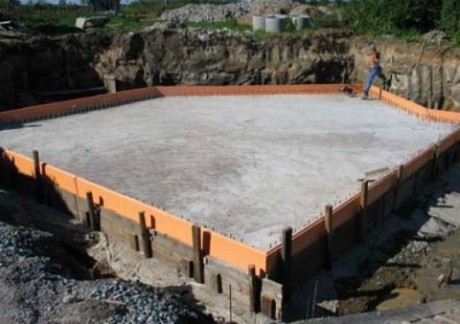 You can start work only after the concrete has completely hardened, on a dry surface!
You can start work only after the concrete has completely hardened, on a dry surface!
Previously, roofing material was used in construction - a roll material in which bitumen was applied to a cardboard base. Its durability was small, since the paper base quickly deteriorated, this material had low bending strength, as well as resistance to high and low temperatures, ultraviolet radiation, etc. The bitumen used in its production also did not have sufficient viscosity and elasticity. As a result, the material quickly cracked and the waterproofing barrier lost its tightness.
Modern materials for the installation of roll waterproofing - rubemast, glass insulation, etc. - are made on the basis of fiberglass or fiberglass. This gives them much more strength. The bitumen, which impregnates the base, contains modifying additives - thanks to this, the material becomes elastic, has significant bending strength, resistance to temperature extremes.
Rolled waterproofing under the foundation slab is convenient to use, as it is simply laid on the gravel-sand dump, without requiring an additional screed. The joints between the strips of material are carefully glued with bitumen mastic. Laying is done quickly and easily; from the devices, only a burner is enough to warm up the mastic. Along the perimeter of the foundation, strips of waterproofing material are bent upward by about 10-15 cm.
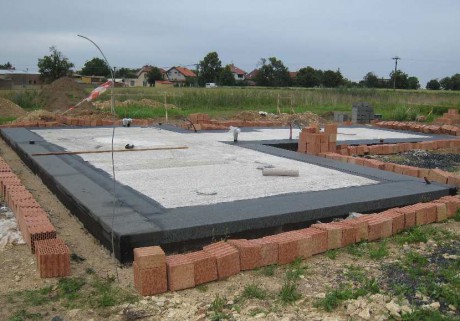 Waterproofing must also be applied to the side surfaces of the foundation.
Waterproofing must also be applied to the side surfaces of the foundation.
Coating waterproofing using bitumen mastics is a more modern way of cutting off water from a monolithic slab.It is the application of modified bitumen to a concrete base using a brush, roller, spray, etc. The difficulty is that for waterproofing the soles of the foundation, it is necessary to lay a layer of cement screed on the sand-crushed stone pillow, on which a layer of bitumen mastic is applied. After pouring the slab itself on top of it, waterproofing is applied to the side and top sides of the foundation.
In a similar way, the penetrating waterproofing of a monolithic slab is performed. A cement screed is laid on the sand and gravel base, which is covered with roll waterproofing materials. After the slab is poured, penetrating insulation is applied to its side and top surfaces. Its principle of operation consists in a chemical reaction between calcium hydroxide (lime), which is contained in concrete, capillary moisture in the thickness of concrete, and active substances that make up the waterproofing material. As a result, the pores of the concrete are sealed with crystalline compounds that prevent the penetration of water. Moreover, this reaction continues for a long time, continuing the "self-healing" of microscopic cracks in the concrete. This method of waterproofing a monolithic slab foundation is the most effective, high-tech and modern.
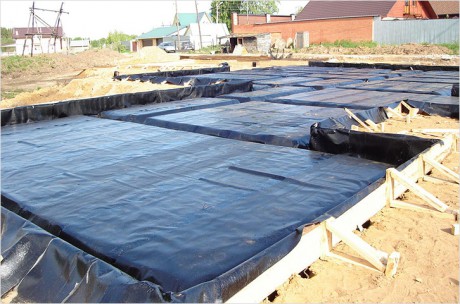 Waterproofing the foundation slab with roll materials
Waterproofing the foundation slab with roll materials

